L7 poultry ticks
1/65
There's no tags or description
Looks like no tags are added yet.
Name | Mastery | Learn | Test | Matching | Spaced |
|---|
No study sessions yet.
66 Terms
Argas persicus
(Fowl tick)
Chicken, turkey, duck, goose, guinea fowl, pigeon and other wild birds;
Can attack humans, dogs etc;
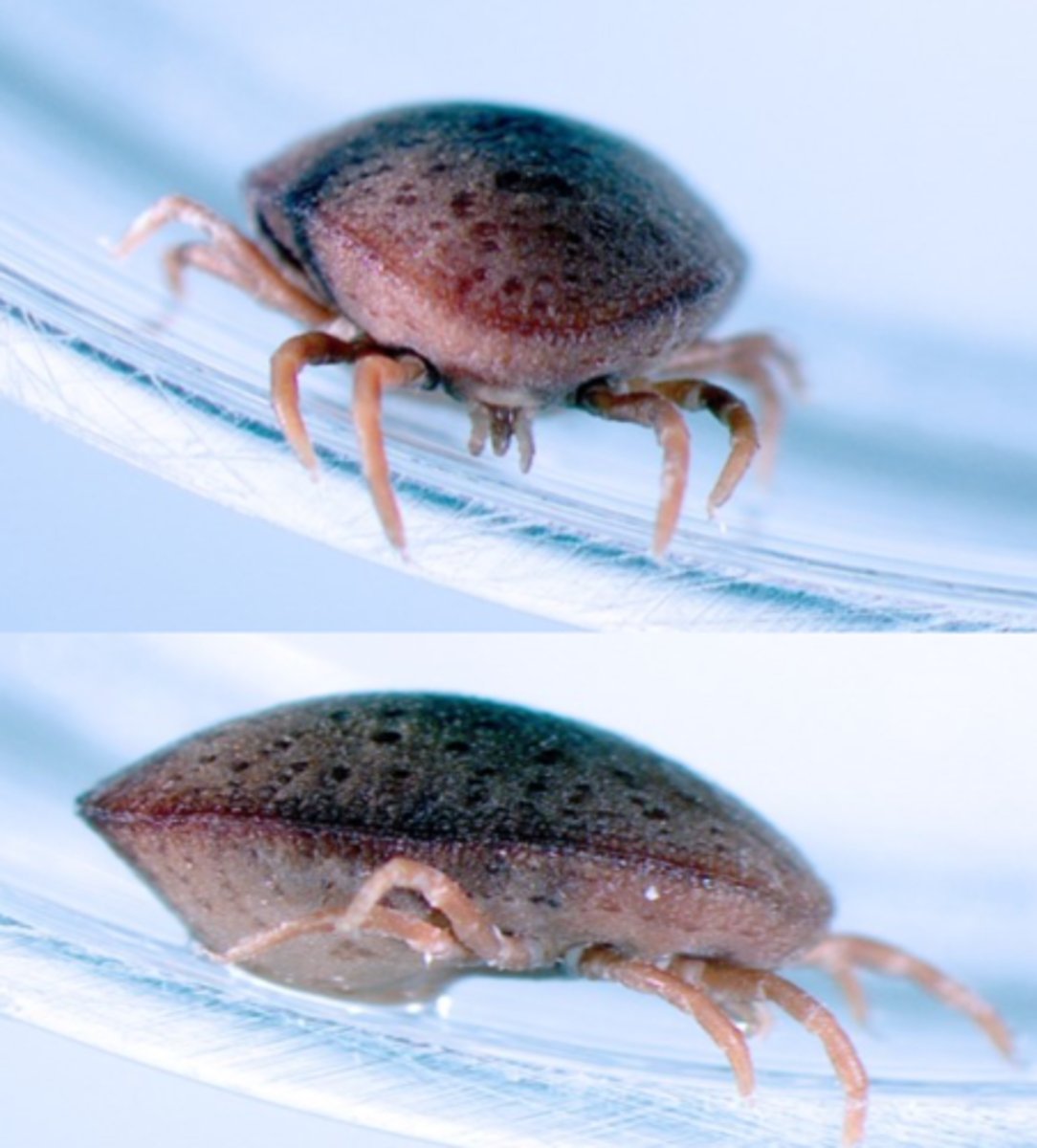
Argas persicus (Fowl tick) Morphology
The shape of the body is oval, narrower at the anterior end;
Gnathosoma in adults/nymphs is located on the ventral surface of body, median, within the anterior third of the body;
Adults and nymphs have 4 pairs of legs: 2 directed anteriorly and 2 directed posteriorly;
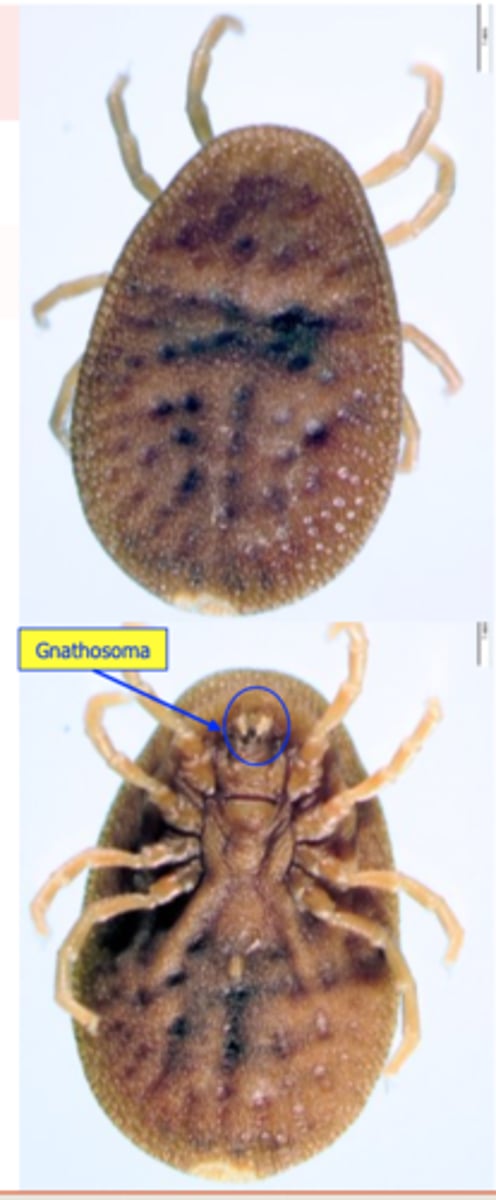
Argas persicus (Fowl tick) Life cycle
Females lay eggs in cracks and crevices of the shelter;
Eggs => larvae: permanent parasites for 5- 10 days => nymphs (2-4 nymphal stages) => adults
• Can survive without feeding for long time, adults more than 4 years
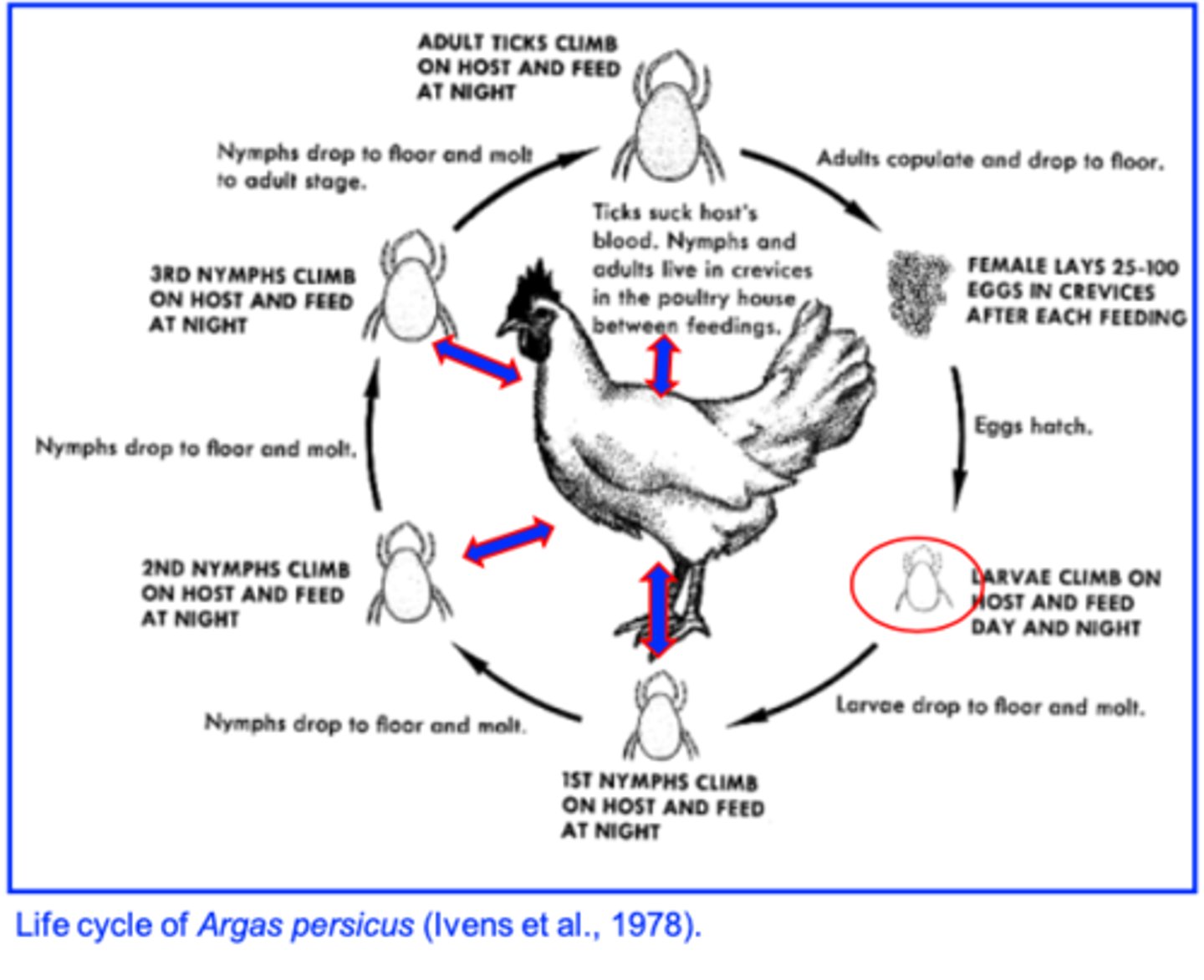
Argas persicus (Fowl tick) Effect on host
• All stages remain around the roosting area;
• Nymphs and adults attack the host and feed during the night
• Larvae attach and feed on the host continuously for 5- 10 days => can cause paralysis;
• Most larvae can be found on the neck, head, under the wings etc => diagnosis;
• Vector for Borrelia anserina, Aegyptianella pullorum.
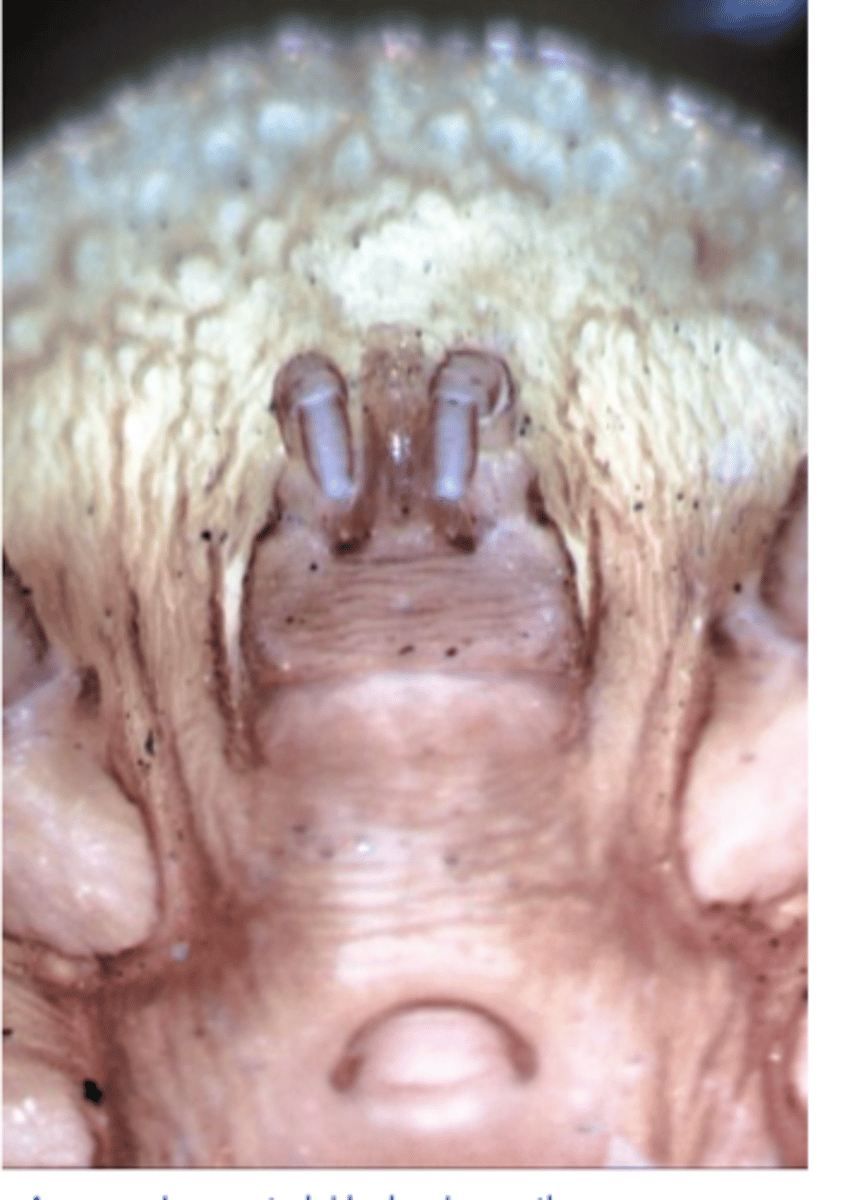
Argas persicus (Fowl tick) Clinical signs
• Heavy infestations => loss of blood => fatal anemia;
• Ruffled feathers, poor appetite => emaciation, weakness, slow growth and lowered production;
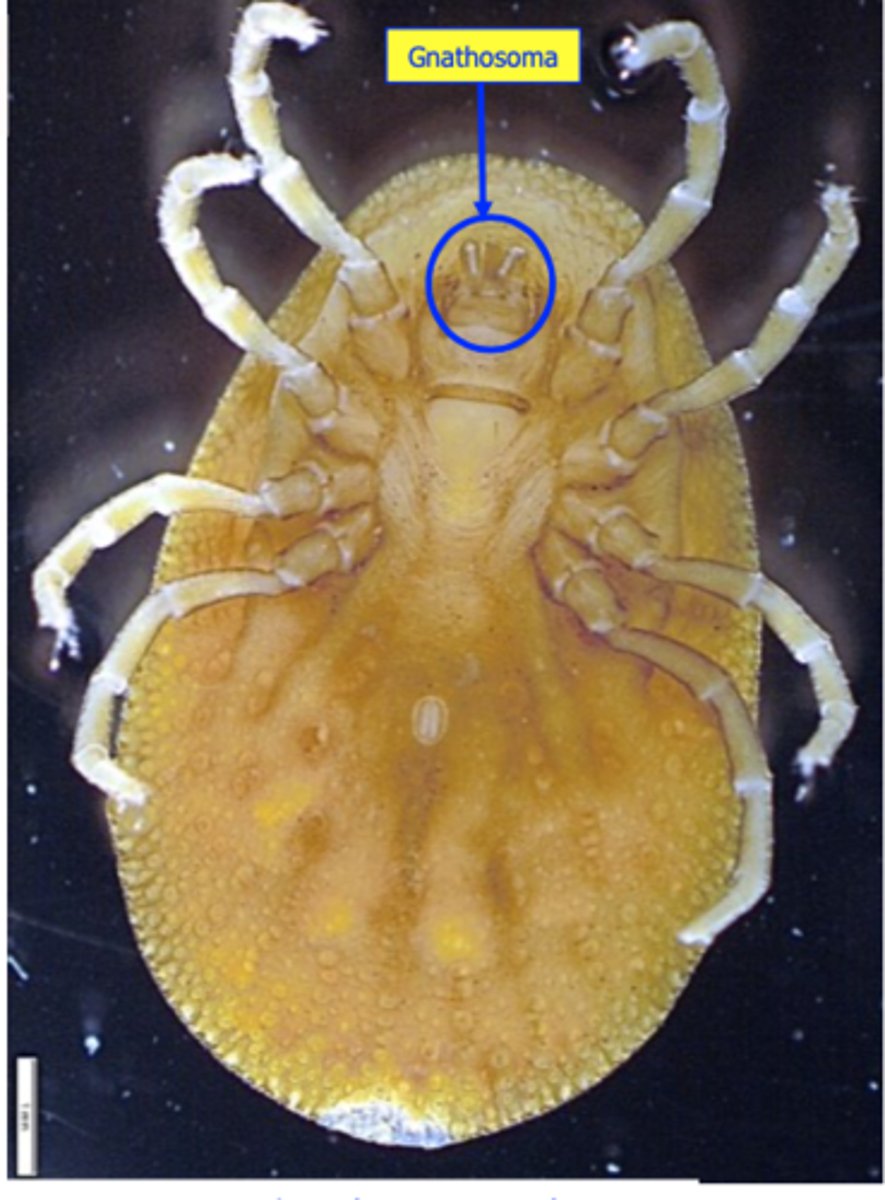
Argas persicus (Fowl tick) Diagnosis
• Clinical signs, history (outdoor systems);
Examination of the birds during the night: larvae, adults, nymphs
Examination of the birds during the day: larvae attached to the skin;
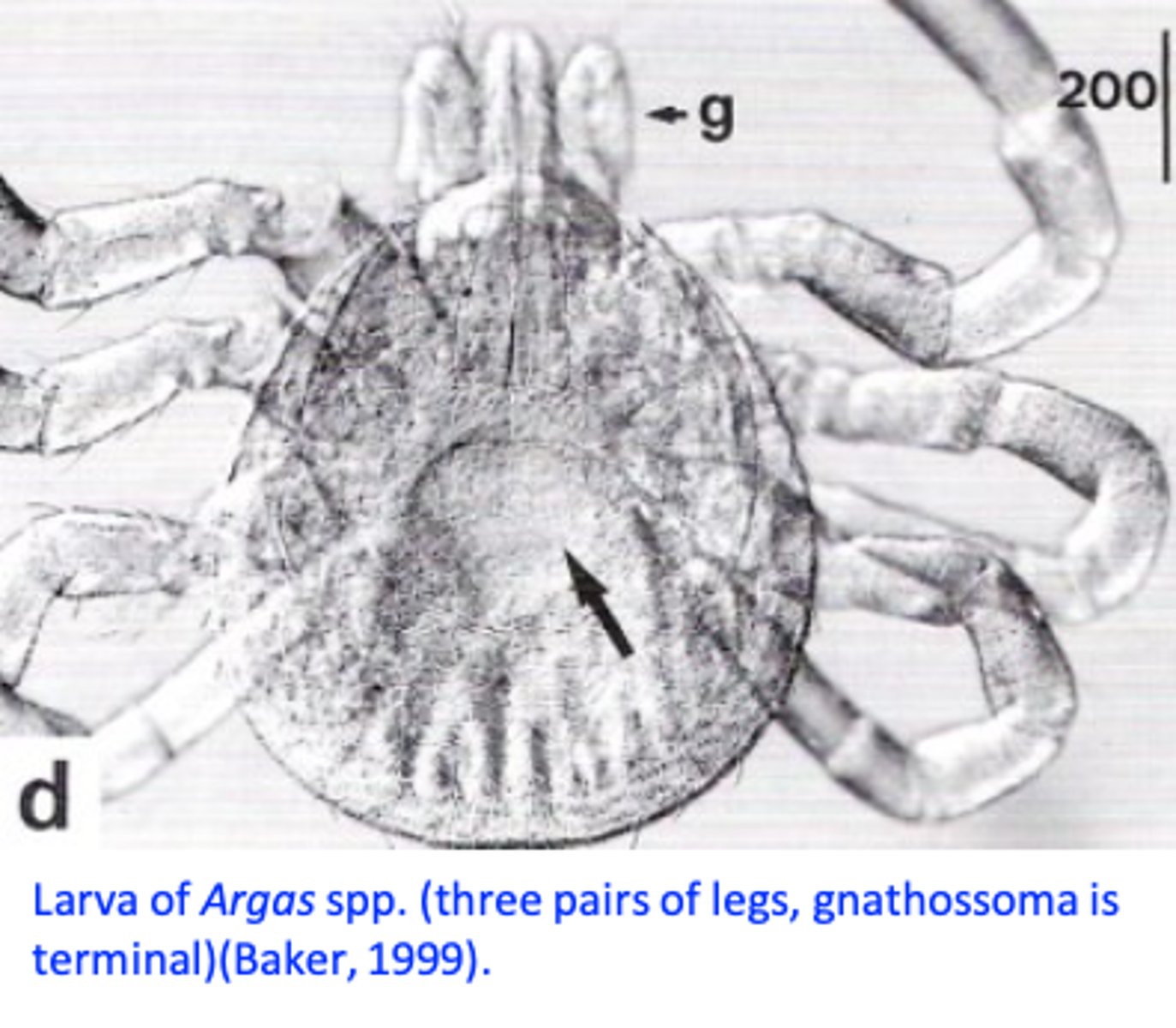
Argas persicus (Fowl tick) Treatment/Control
• Spray or dust the poultry house with approved acaricides
Outdoor runs and feed troughs, woodpiles, and tree trunks
may be treated using insecticides
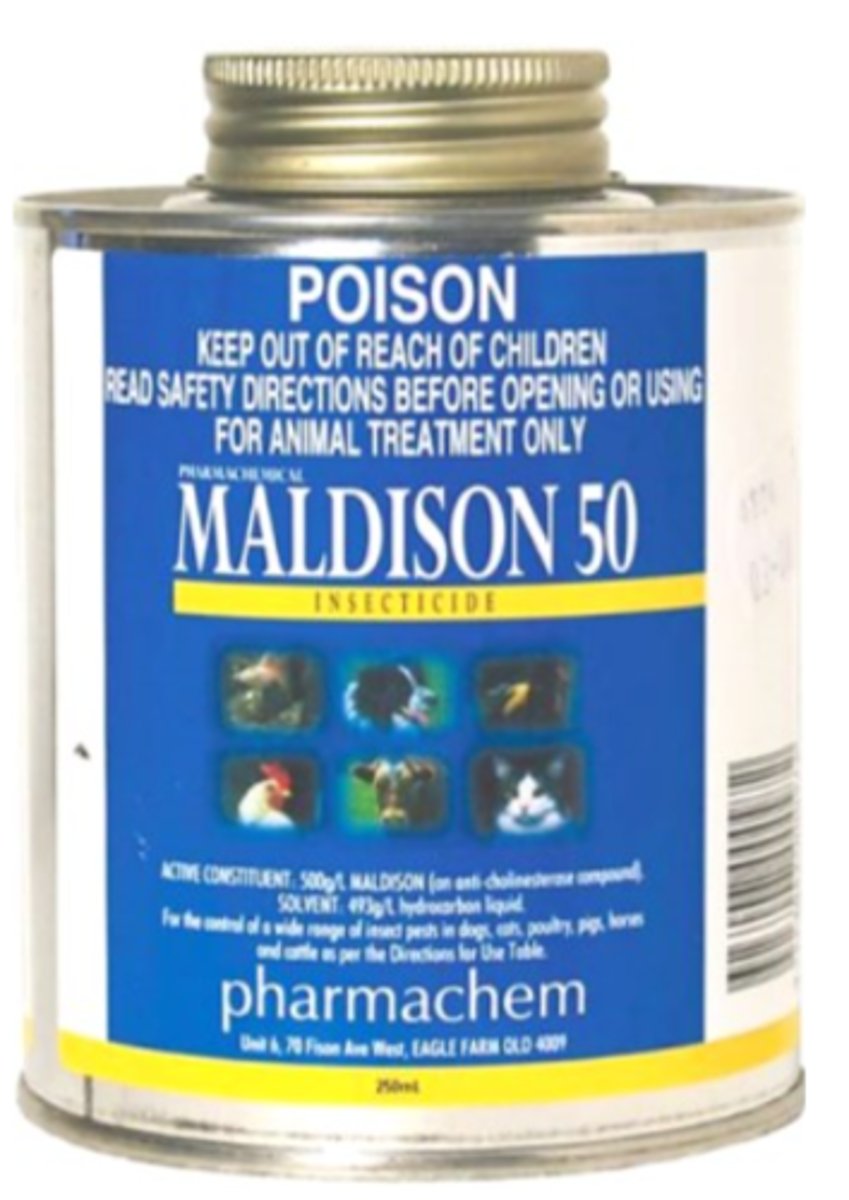
Poultry Mites
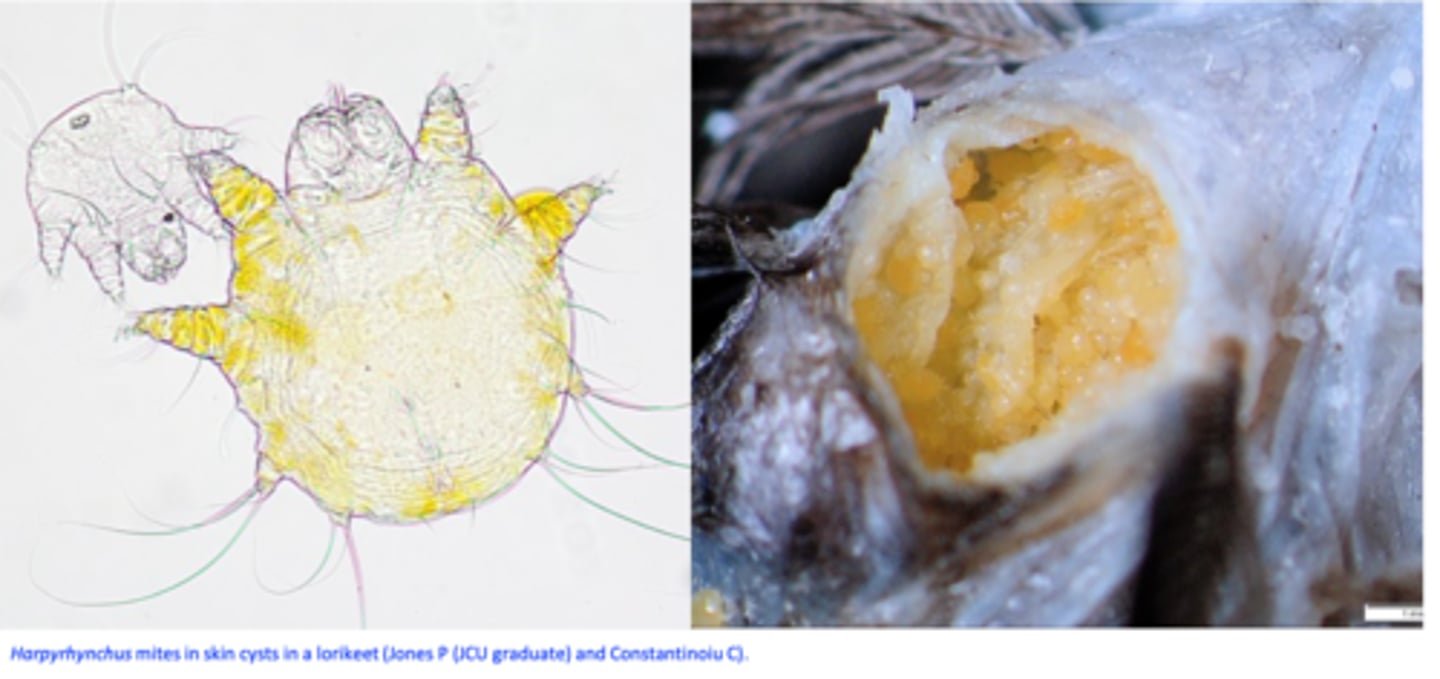
Dermanyssus gallinae (Poultry red mite - PRM)
• Common parasite of birds:
Can bite mammals, including humans;
Vector for bacteria (Salmonella spp., Pasteurella multocida,
Chlamydia spp., Listeria spp, Coxiella burnetti etc) and viruses (Fowl pox, Avian leucosis, Newcastle disease etc);
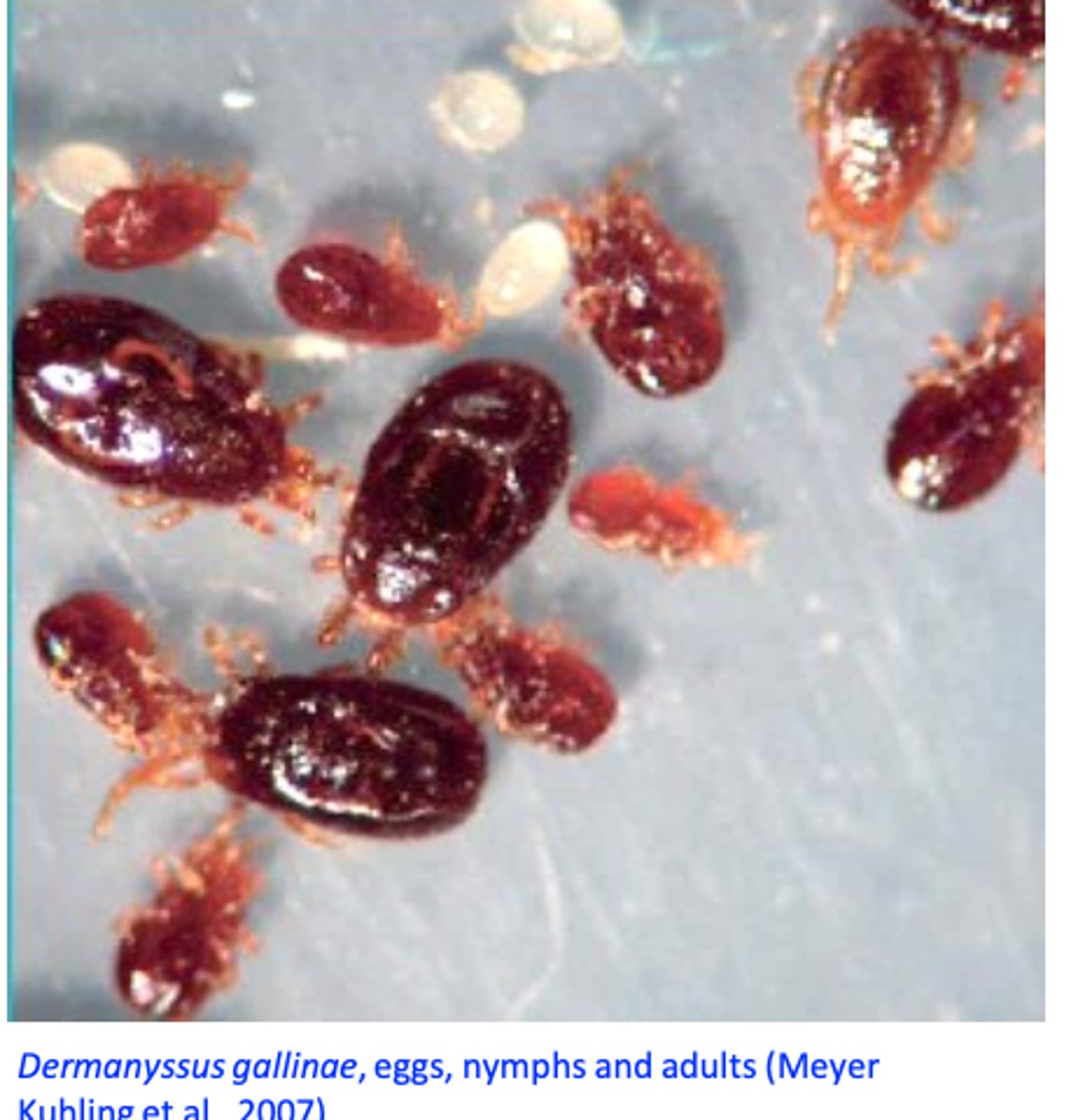
Dermanyssus gallinae - Morphology
Size: 0.8-1 mm, oval body, grey-whitish before feeding, red after feeding;
Four pairs of legs;
Dorsal surface: the plate/shield tapers posteriourly and has its posterior margin straight;
Ventral surface: anal plate is triangular, anus located in the posterior half.
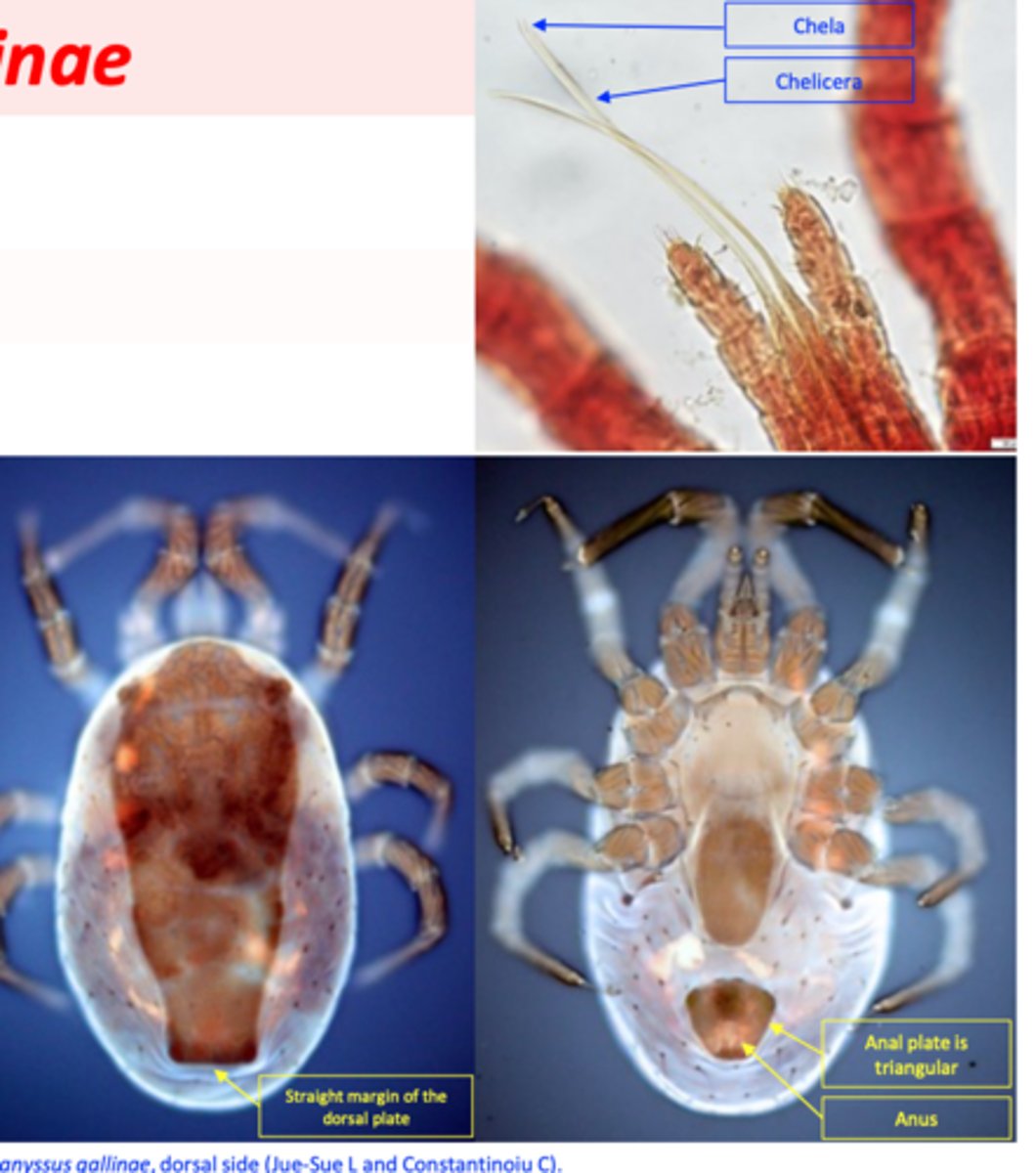
Dermanyssus gallinae (Poultry red mite - PRM) Life cycle
• Spend most of their lifetime in the poultry house, usually hidden in the cracks and crevices;
-• After feeding on the host (during the night) females retreat to cracks and crevices to lay eggs (up to 30 eggs in their lifetime);
• Egg => larva (does not feed) => 2 nymphal stages => adults in 7 days => large populations can develop very quickly;
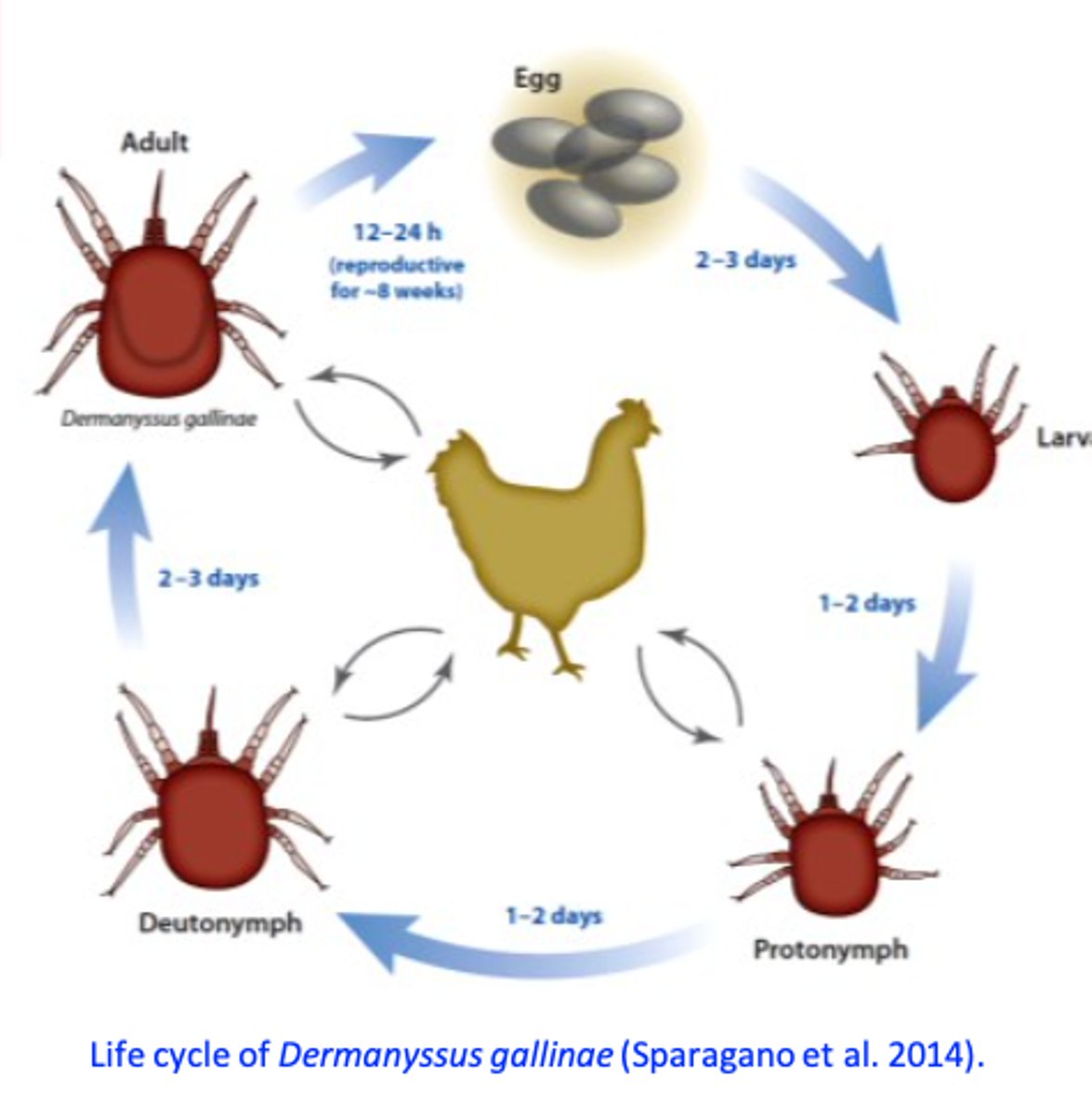
Dermanyssus gallinae (Poultry red mite - PRM) Epidemiology
Distribution: worldwide;
Broad range of hosts: fowl, pigeons, canaries, sparrow,
dogs, cats, horses, cattle, rodents, humans etc;
•Affect birds grown in all systems but commonly prevalence is higher in non intensive systems
• More common in:• Floor systems than in cage systems
• Laying hen farms than in broilers:
• The parasites might be introduced into the farms by : birds, equipment
Bad hygiene, crowding, the presence of the nestlings, high temperatures may stimulate the rapid reproduction and an exponential increase in the mite numbers;
Adult mites can survive up to 9 months without feeding;
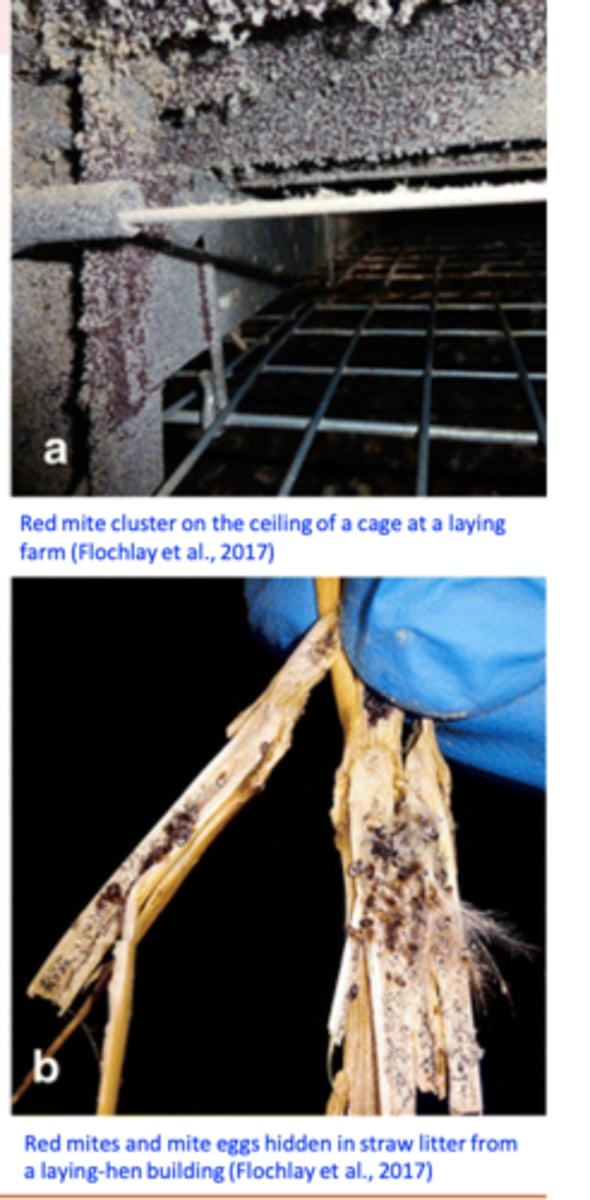
Developmental stages of D. gallinae
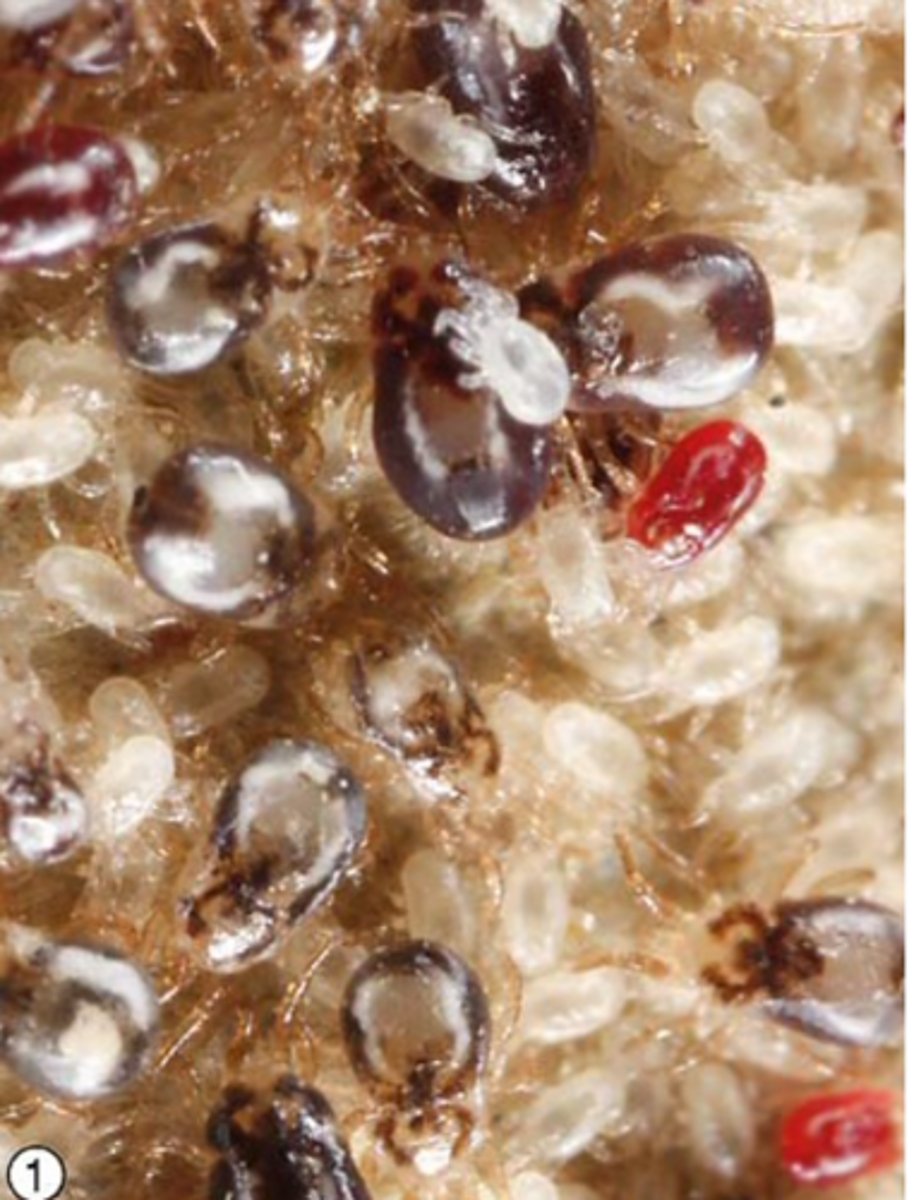
D. gallinae Effect on the host
•Nocturnal blood feeders: during the day they stay hidden in the cracks and crevices;
• Females feed repeatedly, nymphs once and the males occasionally;
• Females that feed can live up to 7 weeks, those do not feed up to 9 months
Dermanyssus gallinae: Effect on the host/clinical signs
Dermanyssus gallinae are very motile, they bite the hosts => irritate the birds that are restless, do not feed and refuse to enter the infested sheds or to lay eggs in the infested nests;
Weight loss, reduced egg production and egg quality -> feeding lesions can be seen on chest and legs
Anaemia, nervousness, damage to the plumage and feather loss
- Chicks may rapidly die
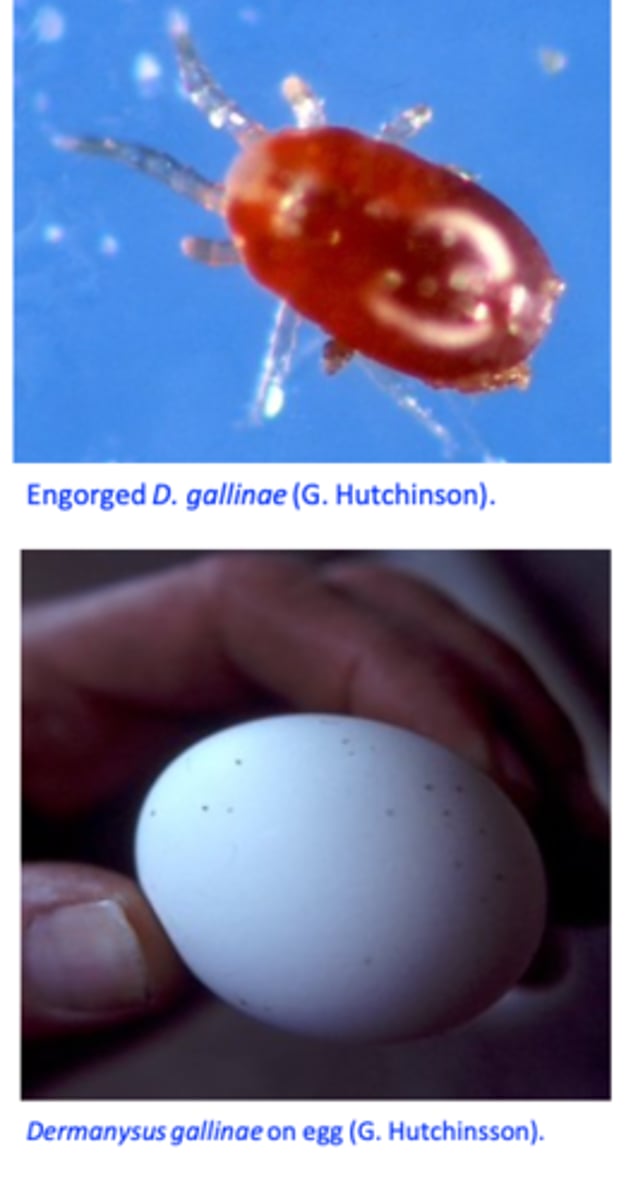
Dermanyssus gallinae: Diagnosis
Clinical signs
Check the birds during the night;
During the day inspect the house and/or use traps.
Necropsy: dead mites in the mucus of oral cavity, rarely in the ear canal or plumage.
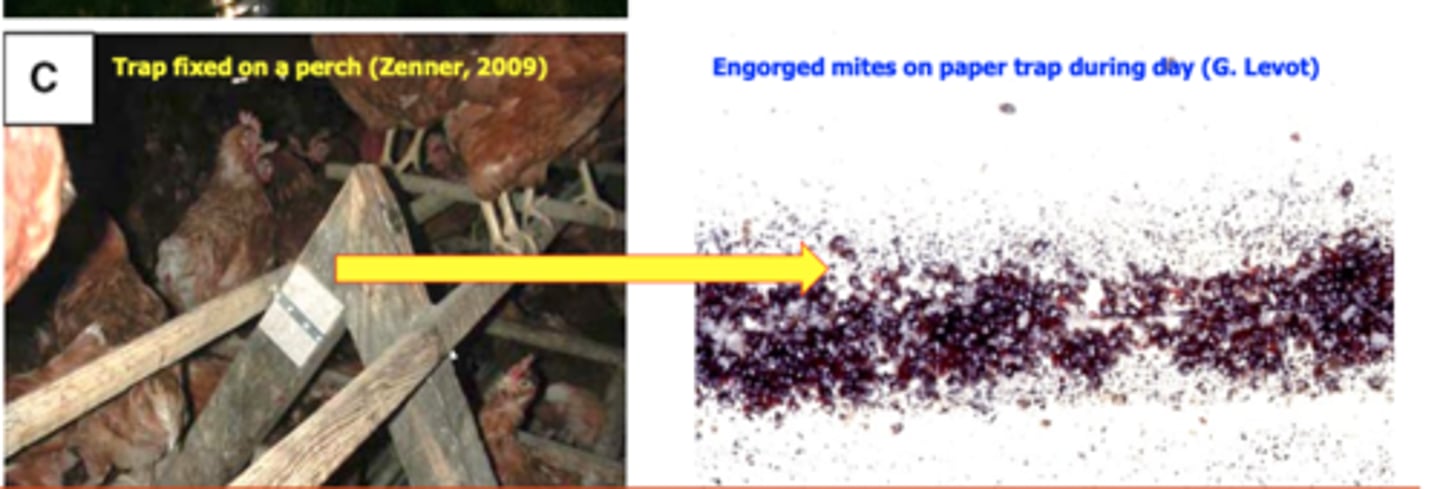
Dermanyssus gallinae: Treatment & Control
a) Treatment of birds was not very successful in the past;
• Fluralaner: Exzolt
• For use in drinking water;• Two doses (0.5 mg/kg body weight), 7 days apart
Treatment of the mites habitat is (was) important
• Clean and spray or dust the poultry house with acaricides: pay attention to cracks, corners, crevices etc;
• Spinosad (Elector PSP Animal Premise spray)
- For suppression of Dermanyssus gallinae populations in
D. gallinae MANAGMENT
Vacuum cleaning the house
Wash the house
• Used clean crates for transport of pullets, destroy rodents, prevent wild birds from gaining access to the house,
Humans and Dermanyssus gallinae
Enter infested poultry sheds during the night/early morning
In houses/hospitals after the wild birds leave the nests built on eaves;
The bites are painful

Ornithonyssus spp. (Fowl mites)
Ornithonyssus sylviarun
(Northern fowl mite - NFM)
Ornithonyssus bursa (Tropical fowl mite)
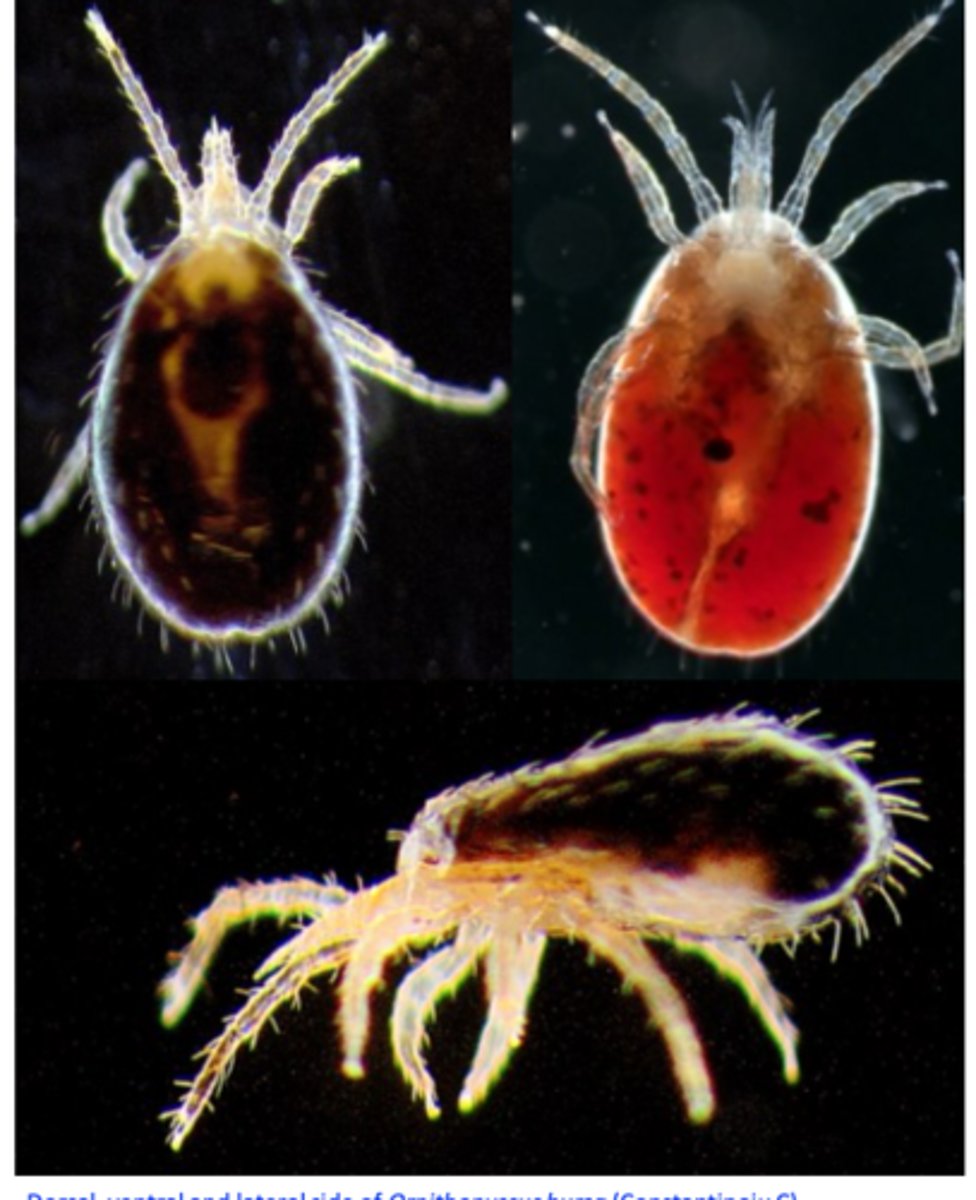
Ornithonyssus spp. (Fowl mites) MORPHOLOGY
• They are similar to Dermanyssus gallinae: usually spinier, anus located in the anterior half of the anal plate, chelae developed
Colour: grey-whitish before feeding, dark red after feeding;
• Anus located in the anterior half of the anal plate, chelae developed;
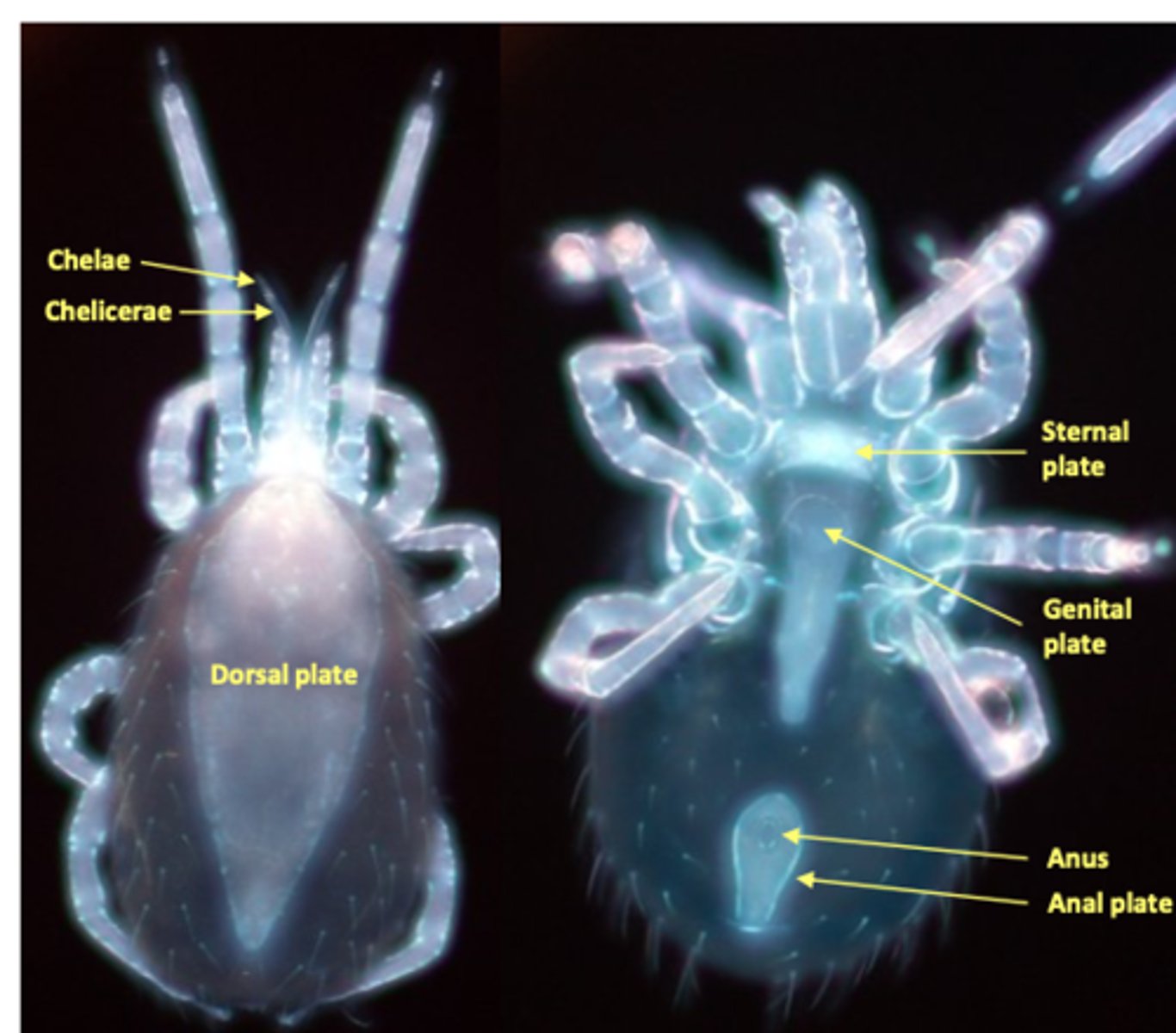
Ornithonyssus MORPH IMAGE

Ornithonyssus sylviarum Life cycle
Ornithonyssus sylviarum
• Most eggs are laid on the host => usually mites spend their entire life on the host
• Short life cycle => big populations can develop quickly on the birds;
THEREFORE TREAT BIRDS
Ornithonyssus bursa LIFECYCLE
• Eggs may be laid on the host or in the litter/nests;
• The mites are on the host for short time to feed;
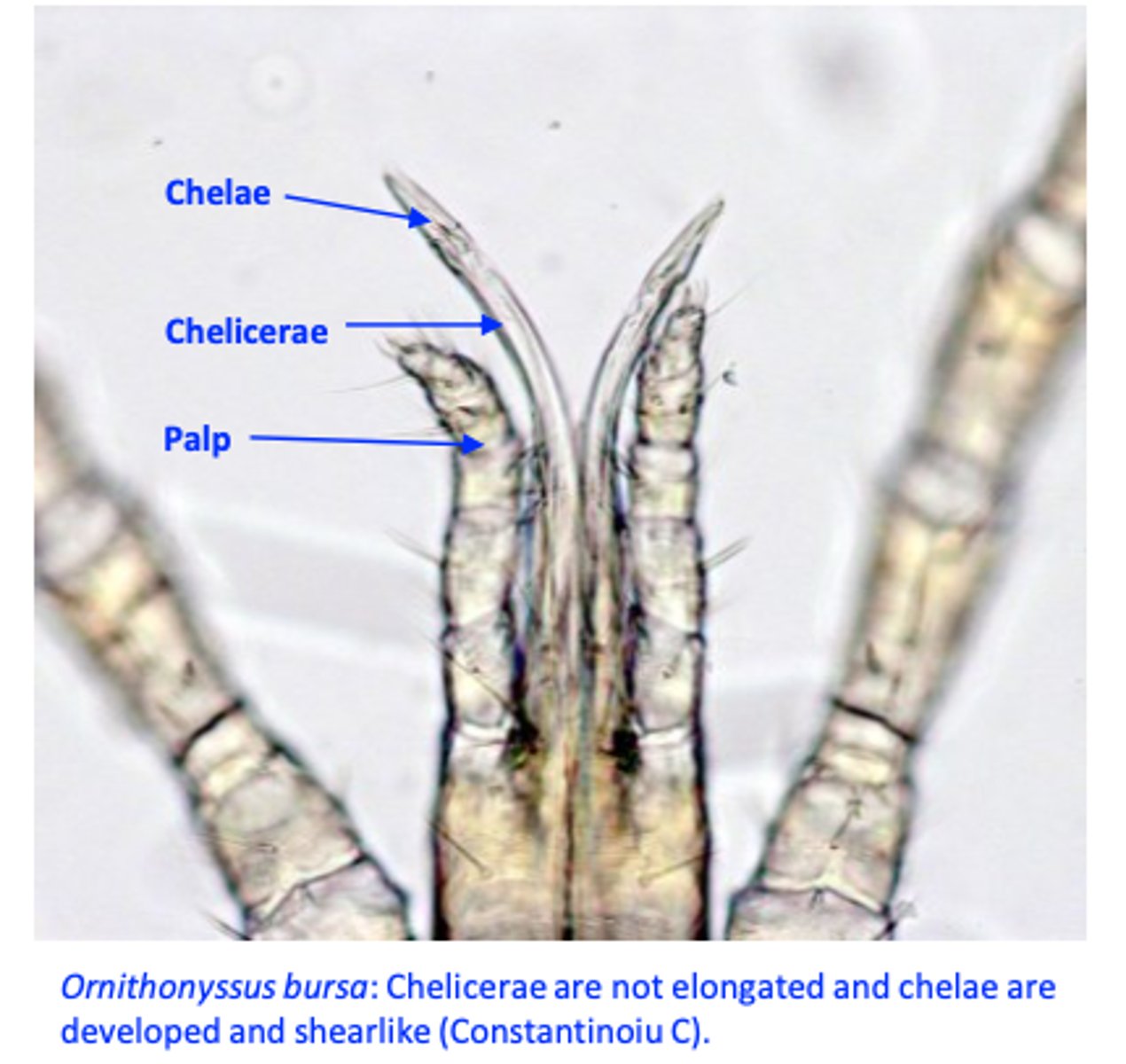
Ornithonyssus sylviarum: Epidemiology
• Commonest and most important poultry
ectoparasite in some countries;
• Present in all production systems, is spread all over the world in the temperate regions
• Infests domestic (hens) and wild birds (pigeons) as well as mammals
Most mites on hens are located on the feathers around the vent;
Infestations are more common in the cold seasons;
The parasites might be introduced into the farms with birds, equipment
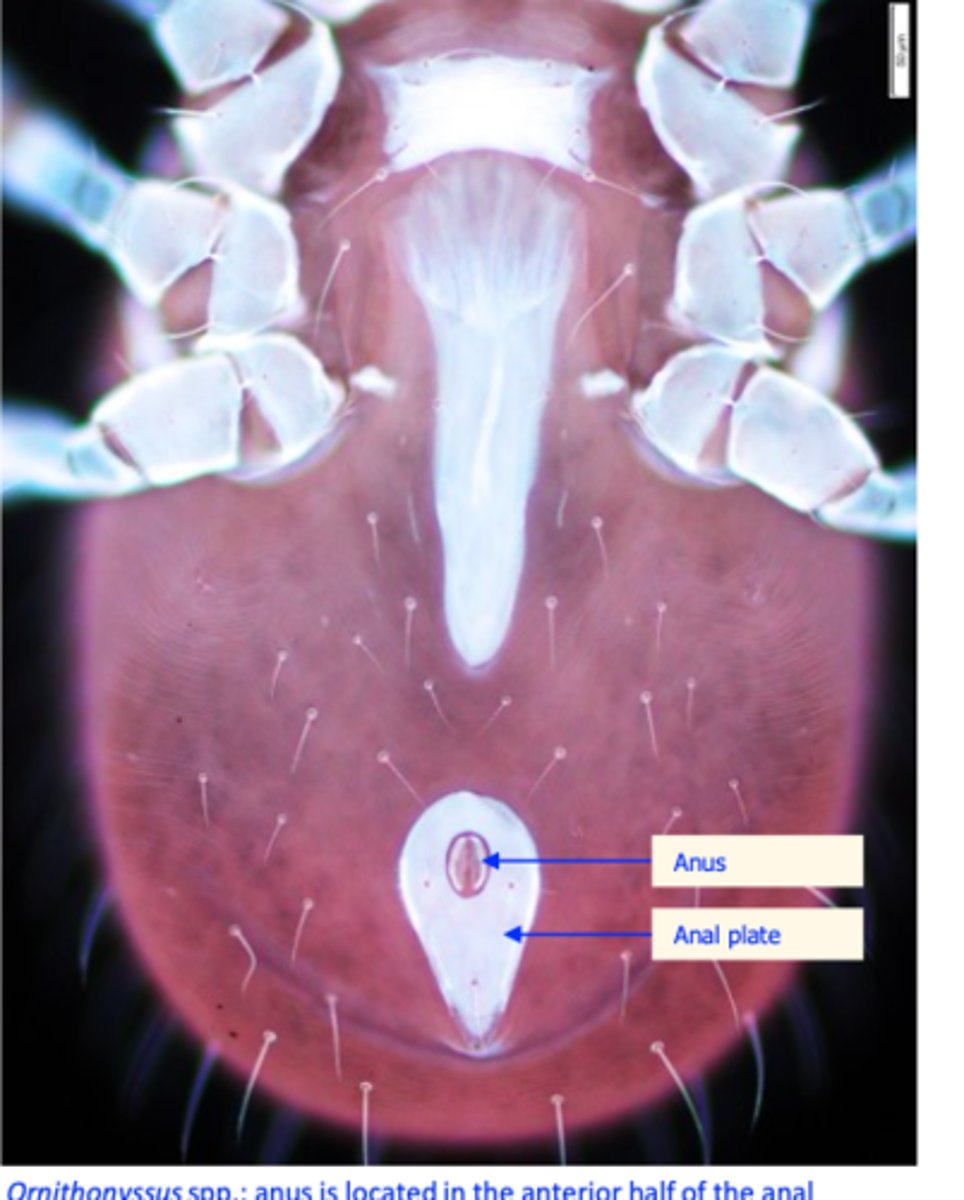
Ornithonyssus sylviarum Infestation occurs
Via direct contact;
By placing birds in accommodation recently
vacated by infected stock;
Mites may be seen off the host => cross empty cages and infest clean birds
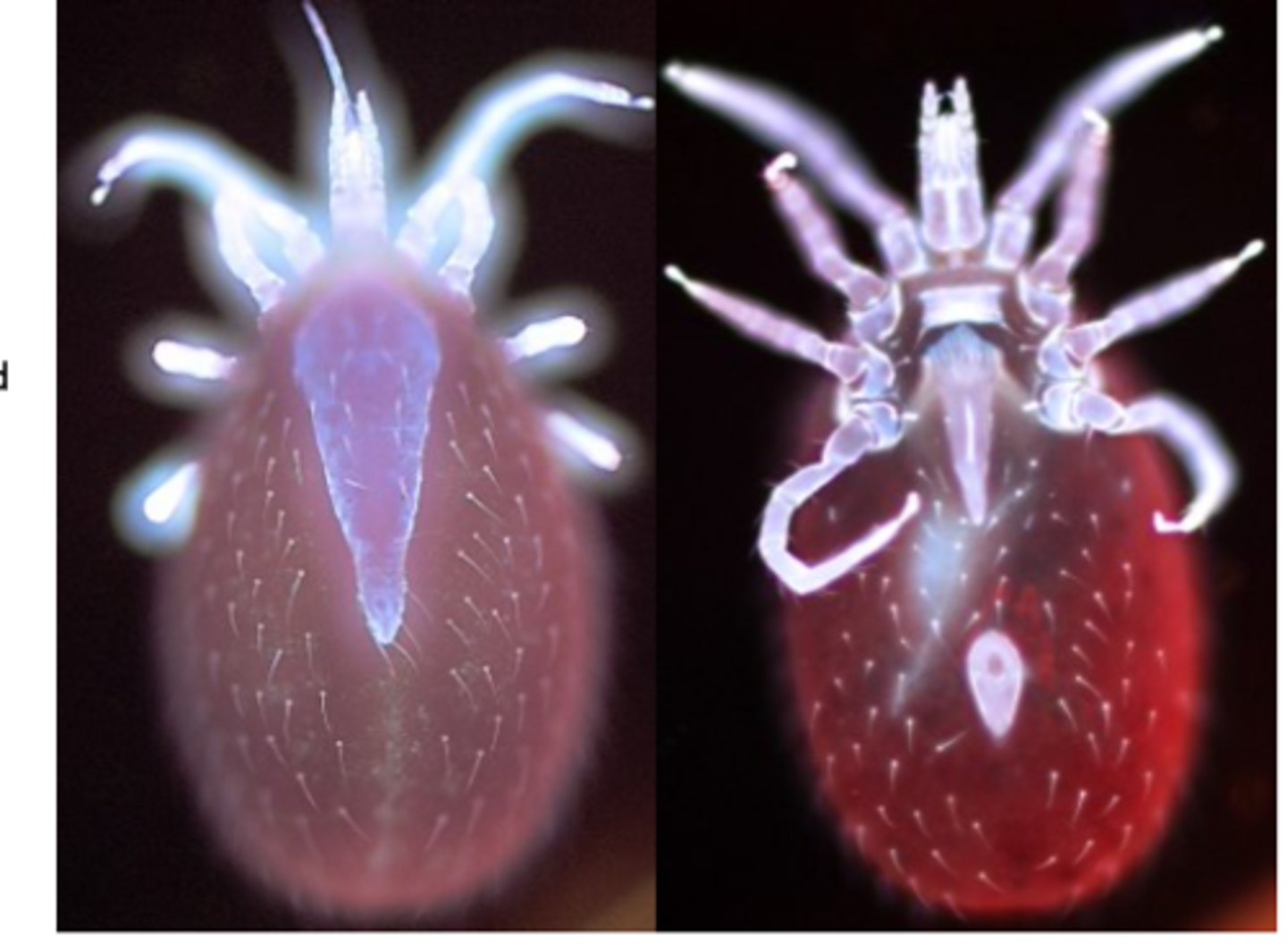
Ornithonyssus spp: Effect on the host/path
Ornithonyssus sylviarum and O. bursa are feeding on blood;
Severe infestations of Ornithonyssus sylviarum may cause up to 6% blood loss/day in caged egg-laying hens;
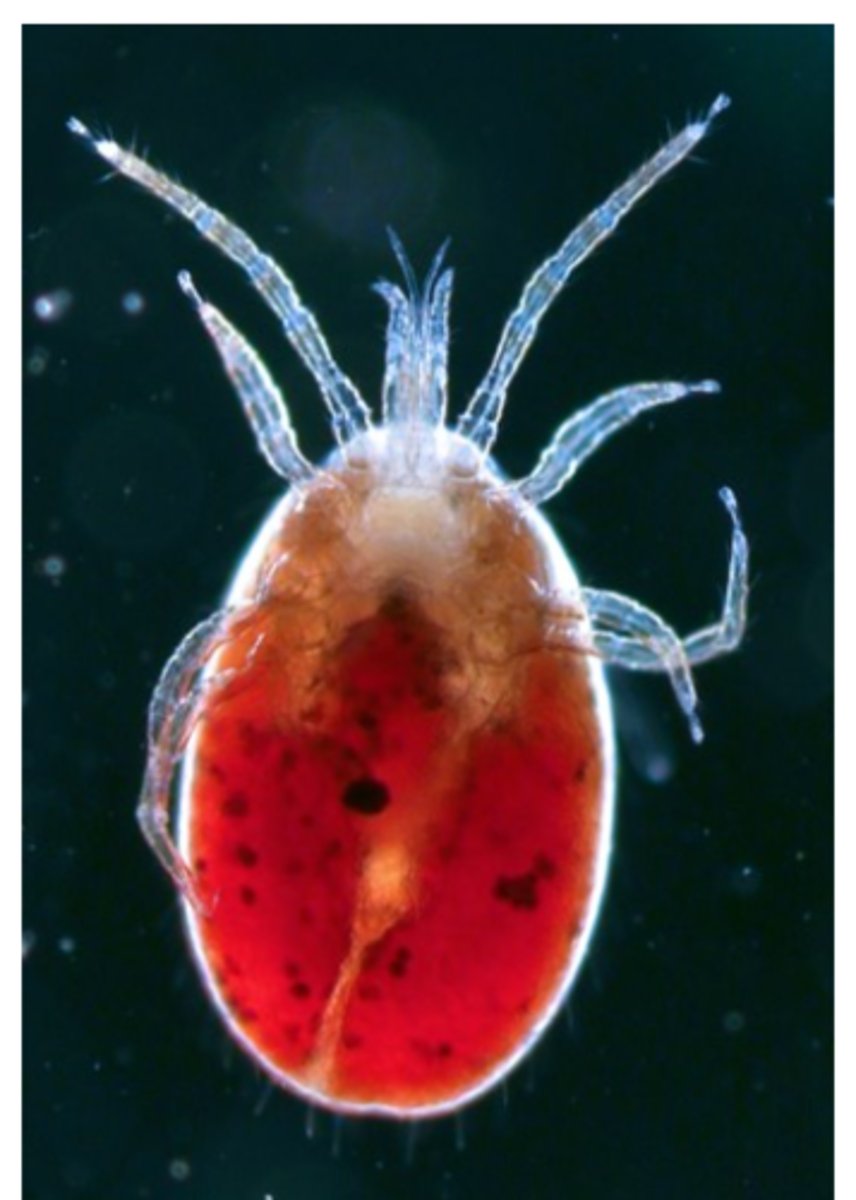
Ornithonyssus sylviarum: Clinical signs
• Ornithonyssus sylviarum locates around the anus
• Feathers may become matted and severe scabbing may develop around vent
• Birds may show a grey-black discoloration of the feathers
• Thickened, crusty and cracked skin and soiled feathers around the anus;
• In heavy infestations, birds are restless, lose weight, egg production may be reduced, anemia etc.
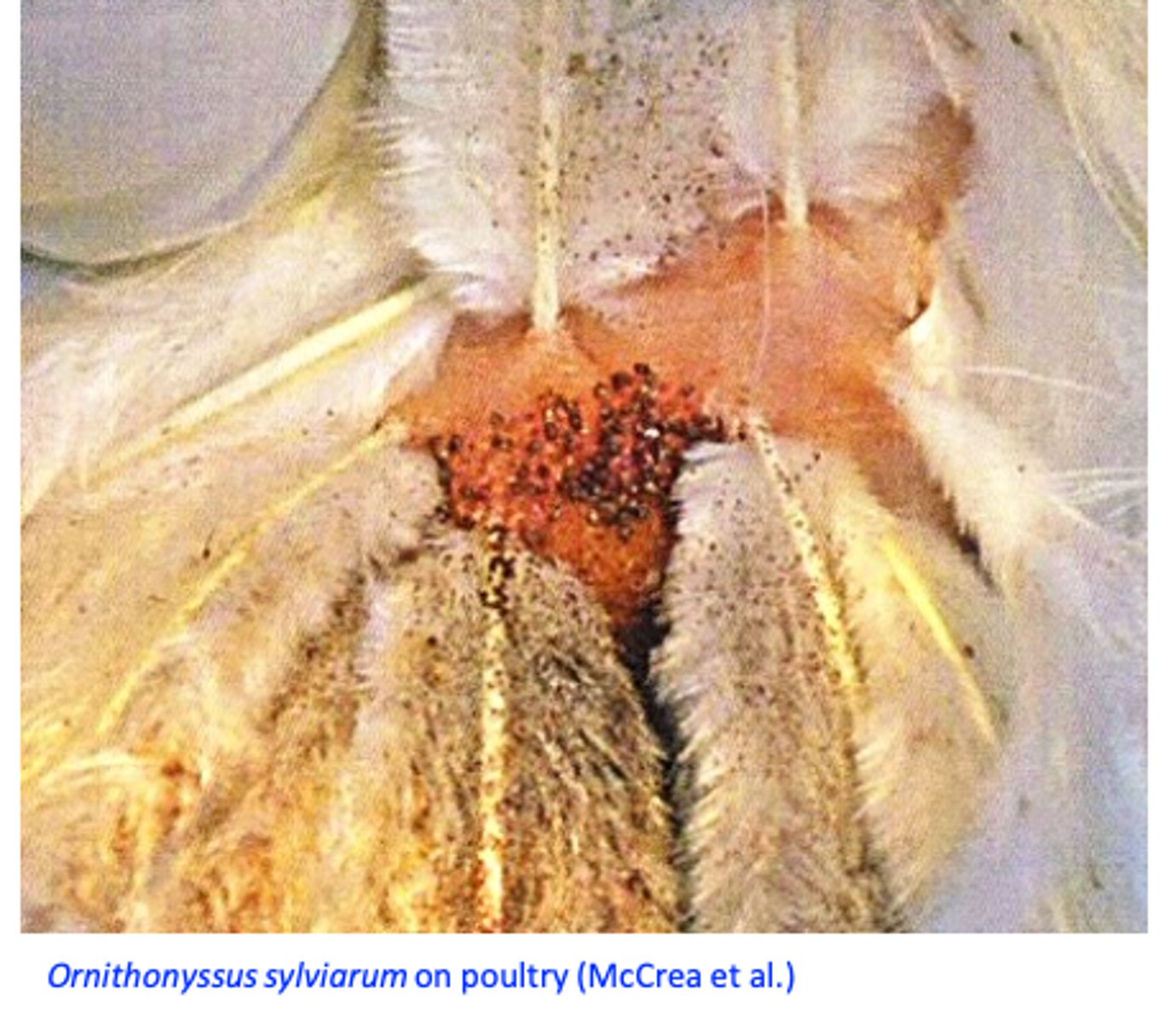
Ornithonyssus sylviarum coin signs image
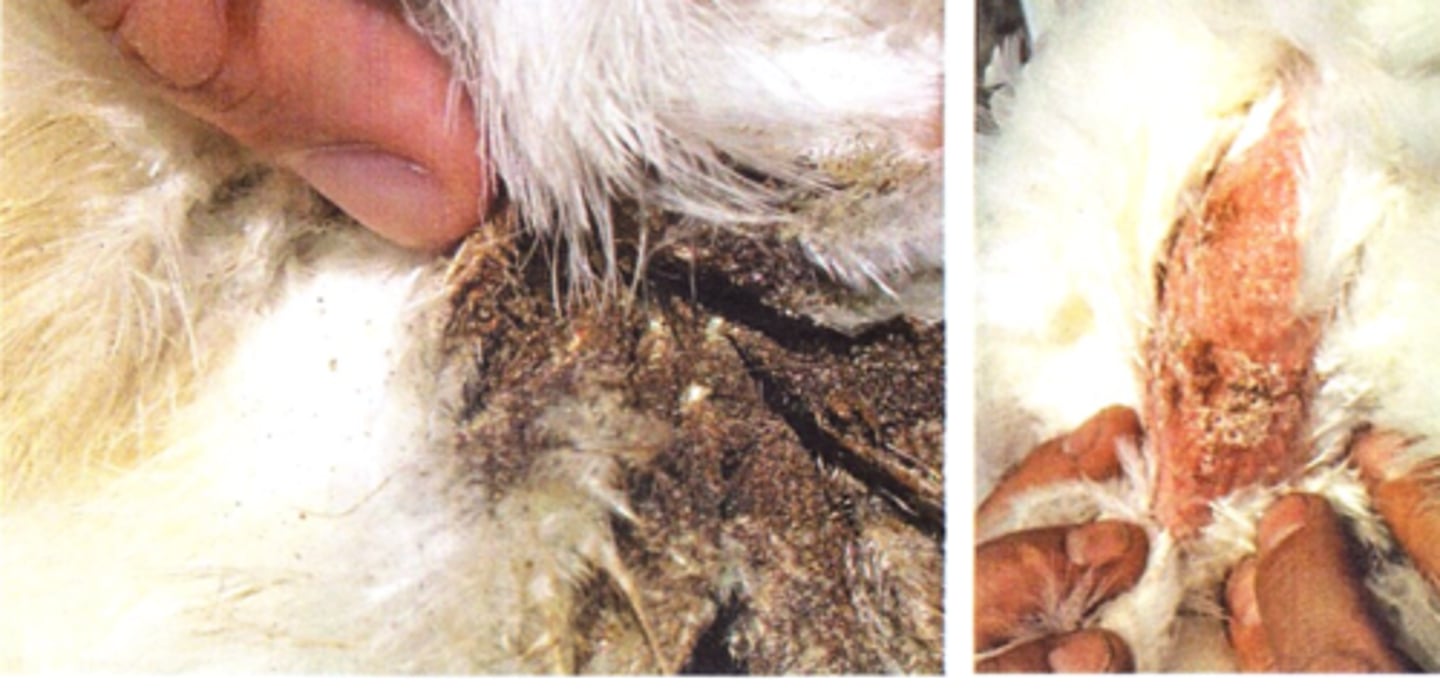
Ornithonyssus bursa (Tropical fowl mite)
The preferred feeding sites are on the head, vent etc but in heavy infestations the mites will be
found on all body parts
Large numbers of parasites give the feathers a dirty appearance;
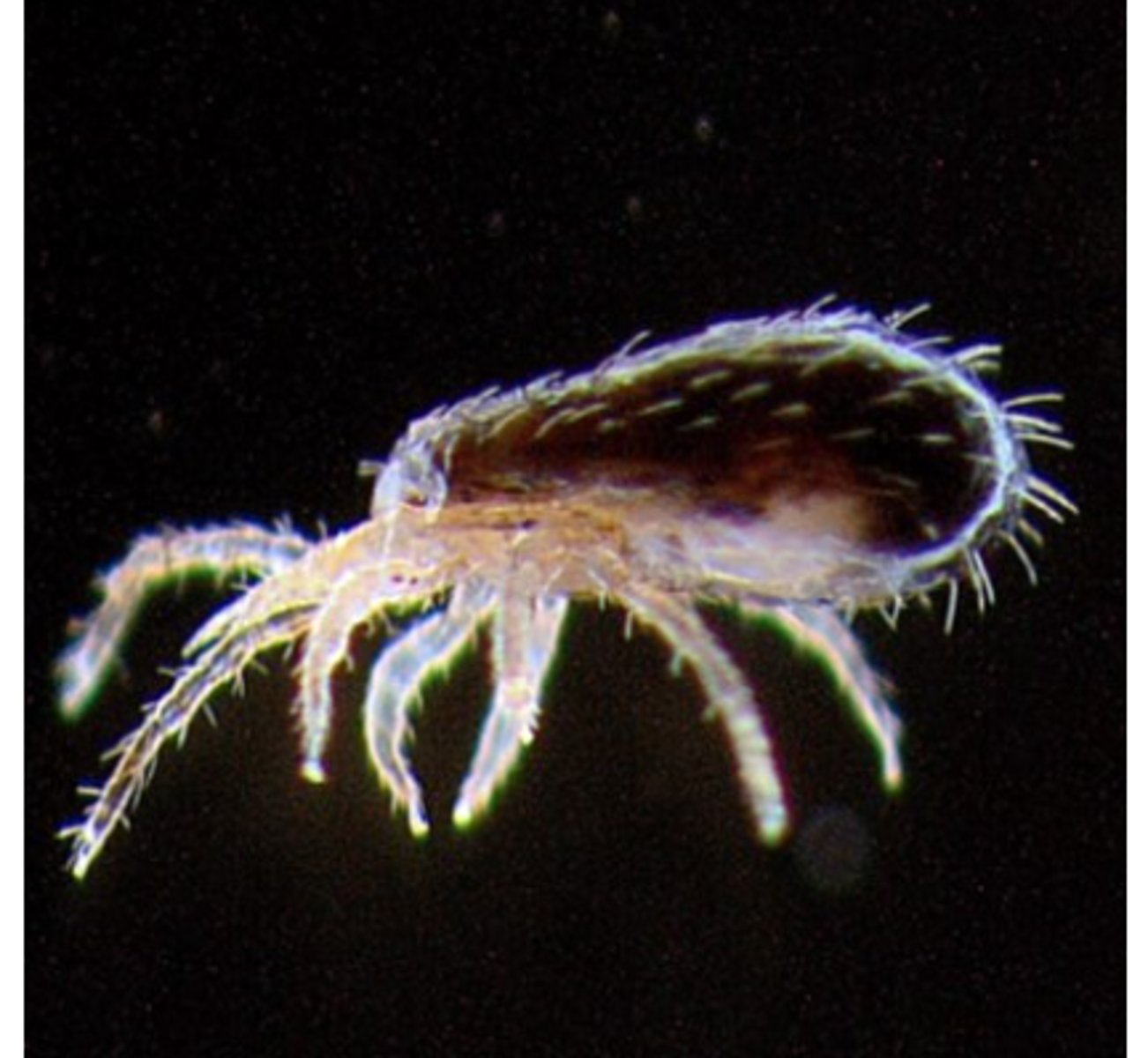
Ornithonyssus spp: Diagnosis
• Clinical signs;
Mites may be found on the birds during the day and night;
Mites may be seen crawling on the eggs/hands of the personnel handling poultry/eggs
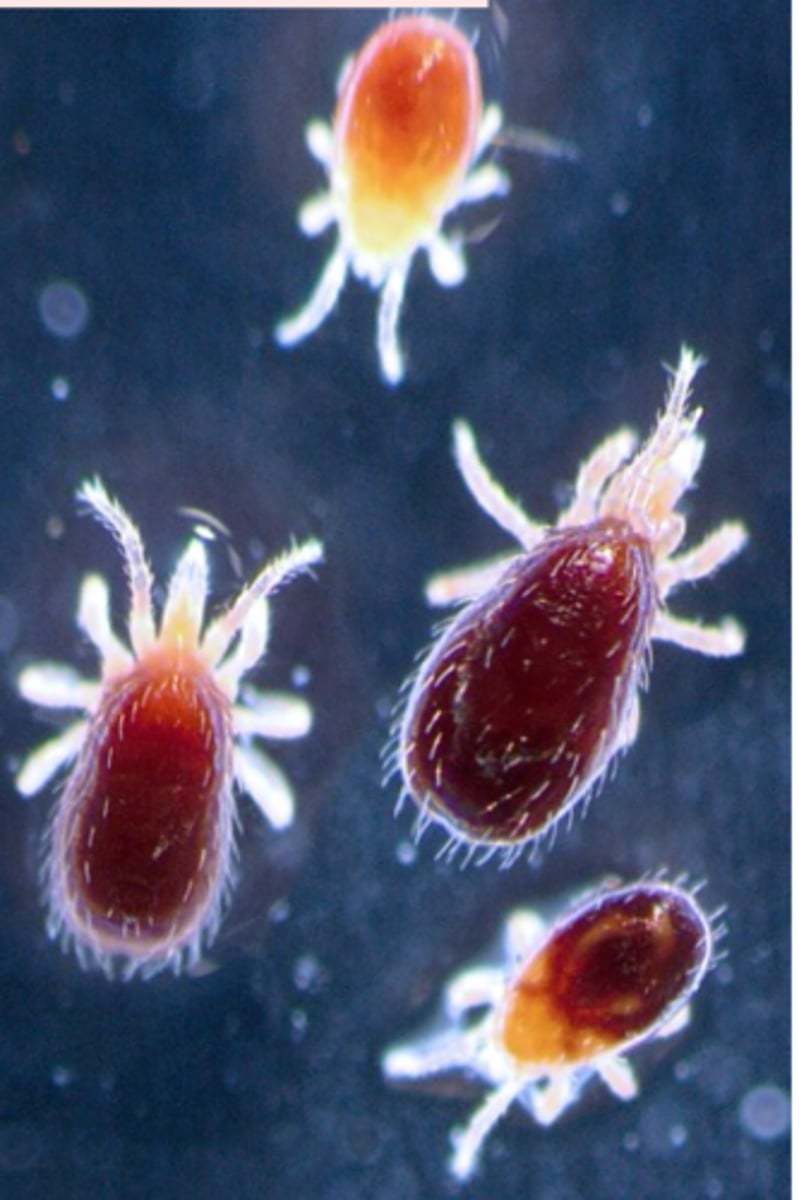
Ornithonyssus spp. Treatment
Maldison (OP) check is still approved
Pestene - mites & lice
Pyrethroids - check is approved
- Plastic strips impregnated with Permethrin
• Spinosad (Elector PSP)
• Fluralaner (Exzolt) - not approved in AUS yet
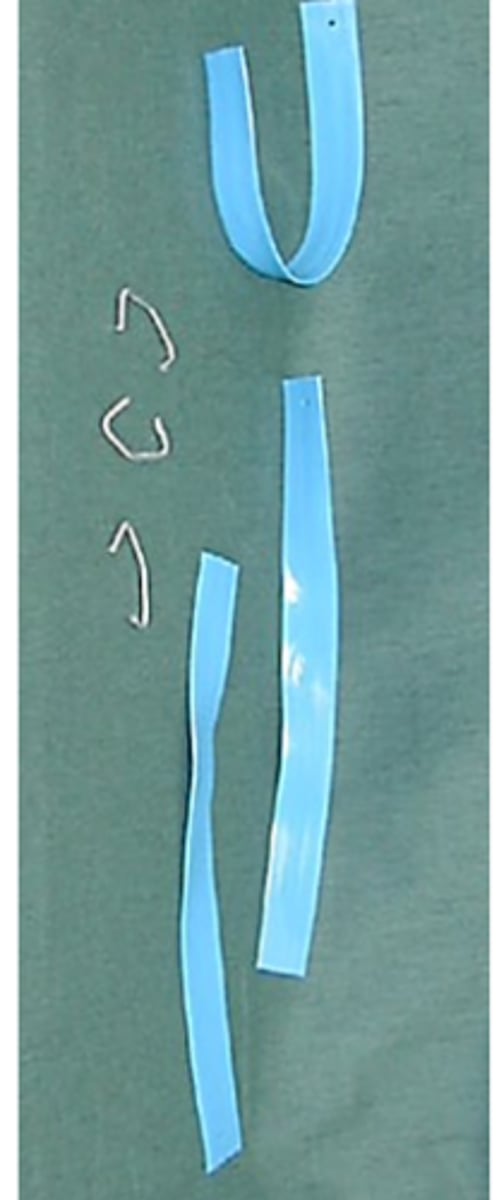
Ornithonyssus spp CONTROL
Chemo-resistance to organophosphates and pyrethroids has developed;
Dry heat/steam;
Prevent the introduction of the mites to the farm:
Monitor flocks weekly;
Like Dermanyssus gallinae, Ornithonyssus spp. might attack humans!!!
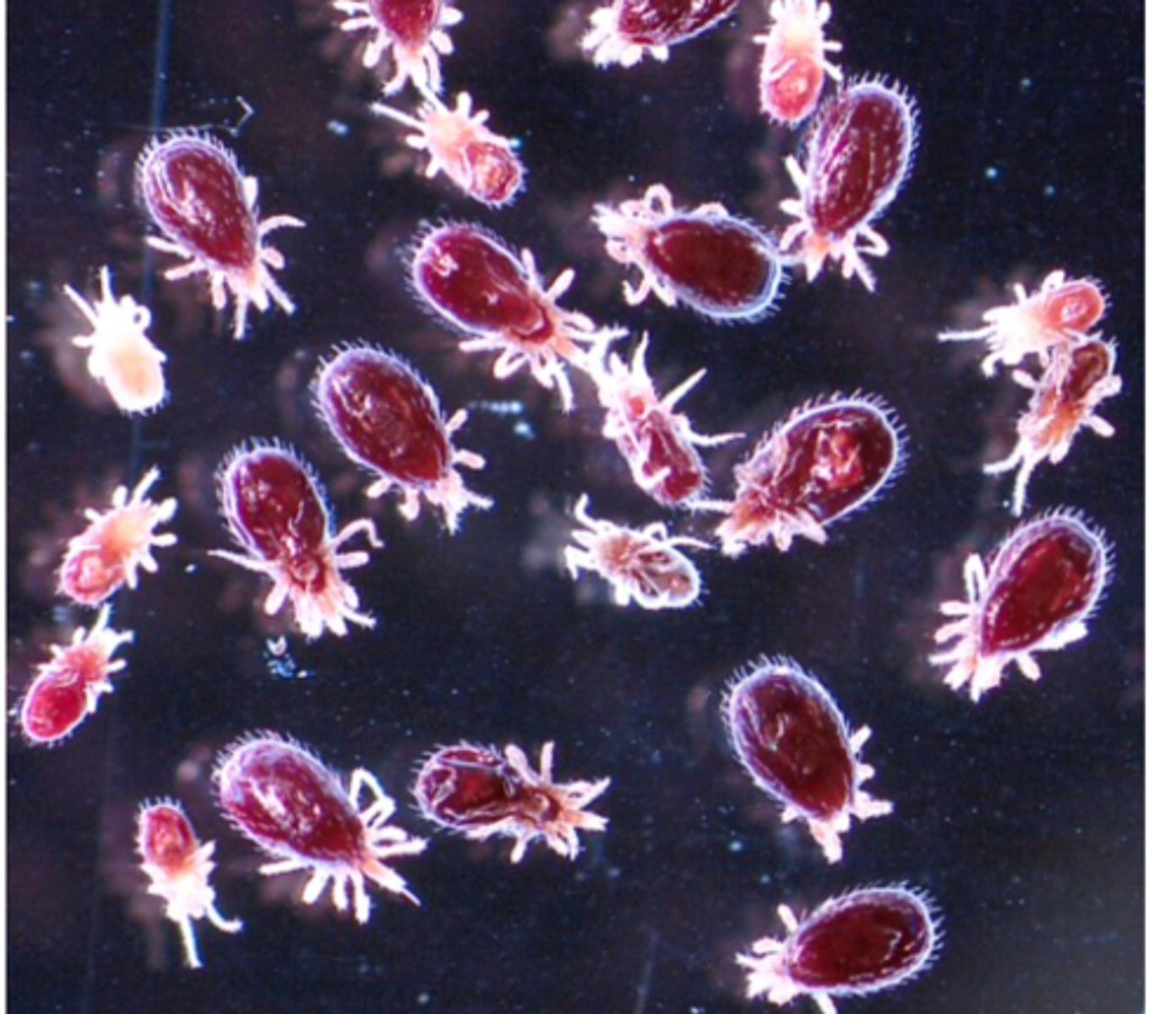
K(C)nemidocoptes spp.
Cnemidocoptes mutans (Scaly leg mite)
• On legs of chickens
Cnemidocoptes gallinae (Depluming mite,
depluming itch mite)
• In feather shafts of chickens
Cnemidocoptes pilae (Scaly face mite)
• On beak and legs of psittacines
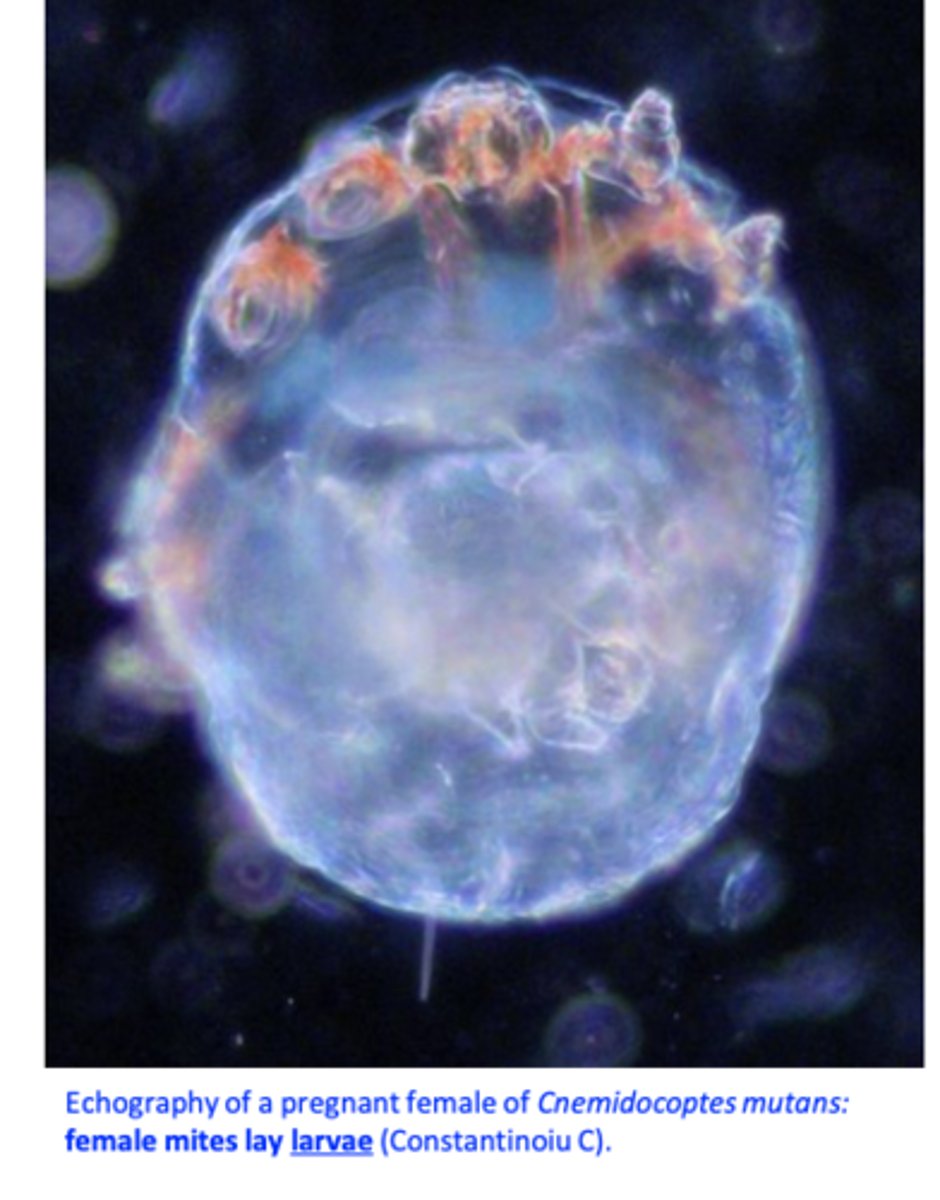
K(C)nemidocoptes mutans: Scaly leg mite
Location: under the scales of the legs => Scaly leg mite.
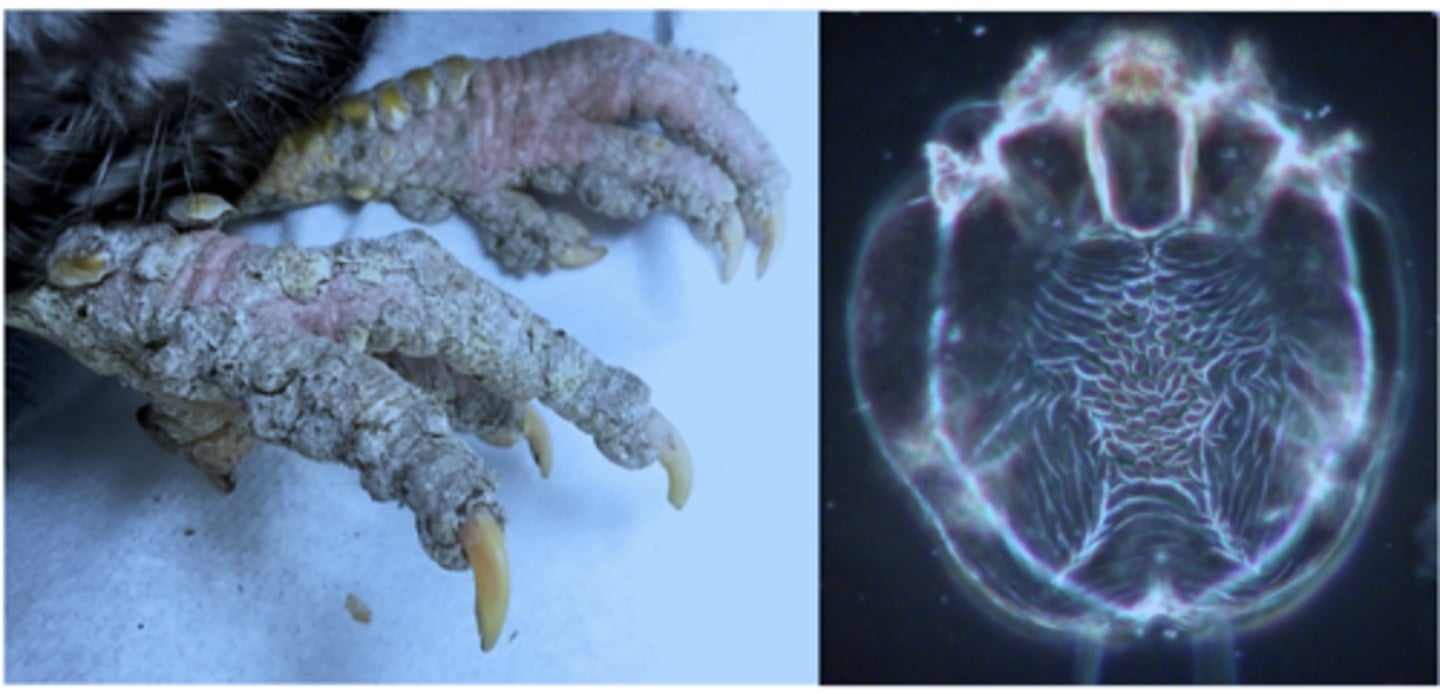
K(C)nemidocoptes mutans: MORPH
Circular
Gnathosoma is short, wider than longer;
In females dorsal surface has a scaly aspect;
The legs are short, stuby;
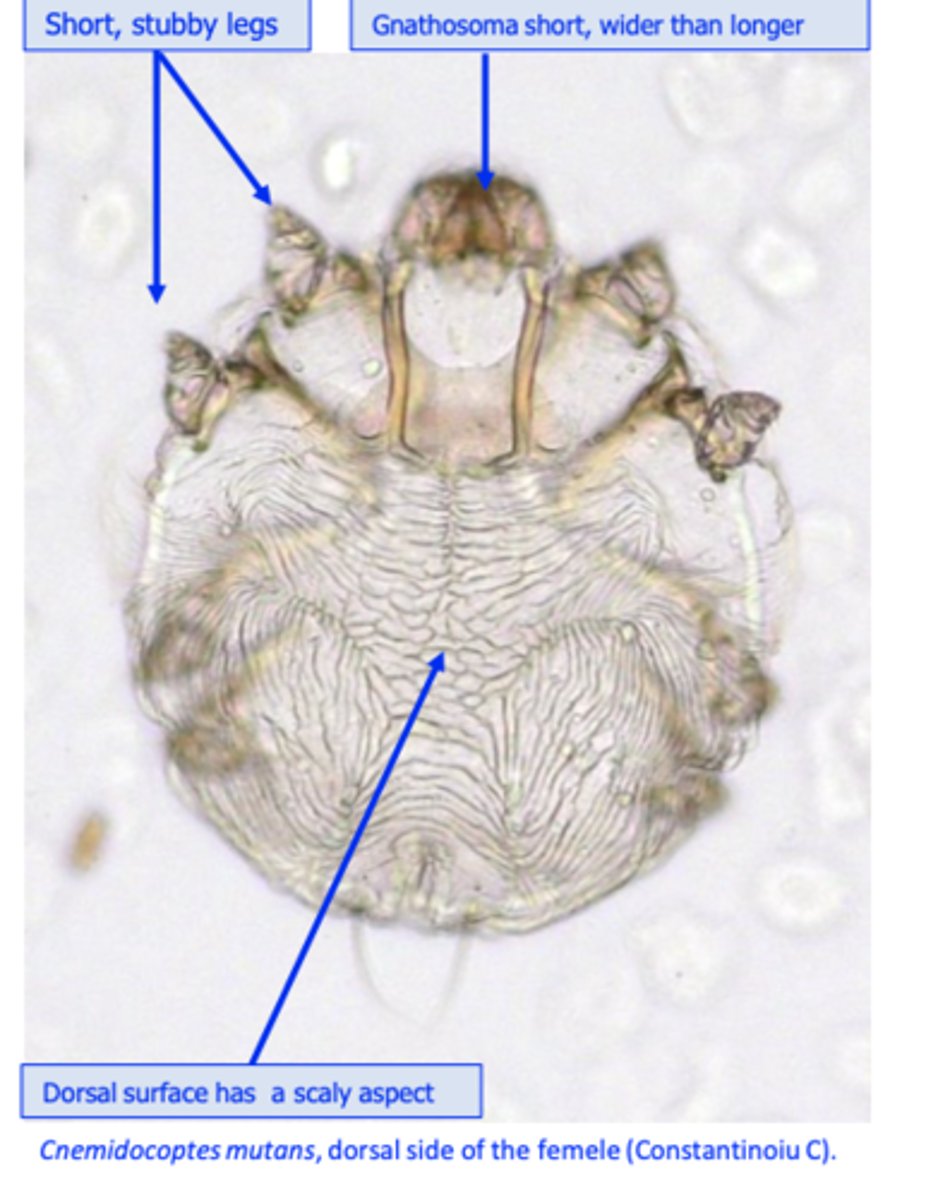
K(C)nemidocoptes mutans: LIFECYCLE
Female mites give birth to (hexapod) larvae => octopod
protonymphs => tritonymphs => adults
• The life cycle is spent on the host and it is completed in 2-3 weeks;
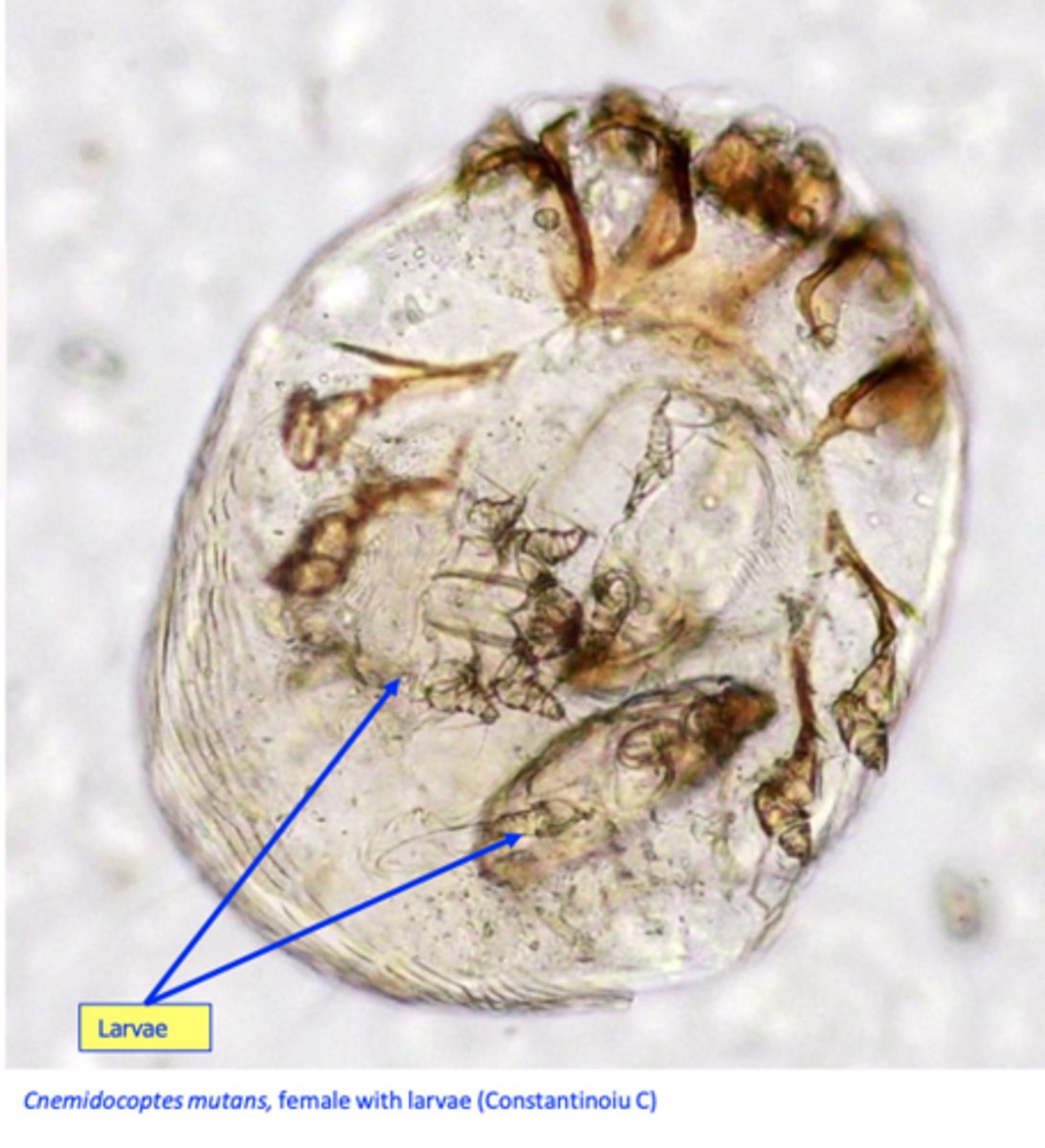
K(C)nemidocoptes mutans: EPIDEMIOLOGY
• Host: domestic chicken, turkey, pheasant;
• Usually affects older birds;
• Infection: contact with infested birds; the mite might be picked-up from the ground;
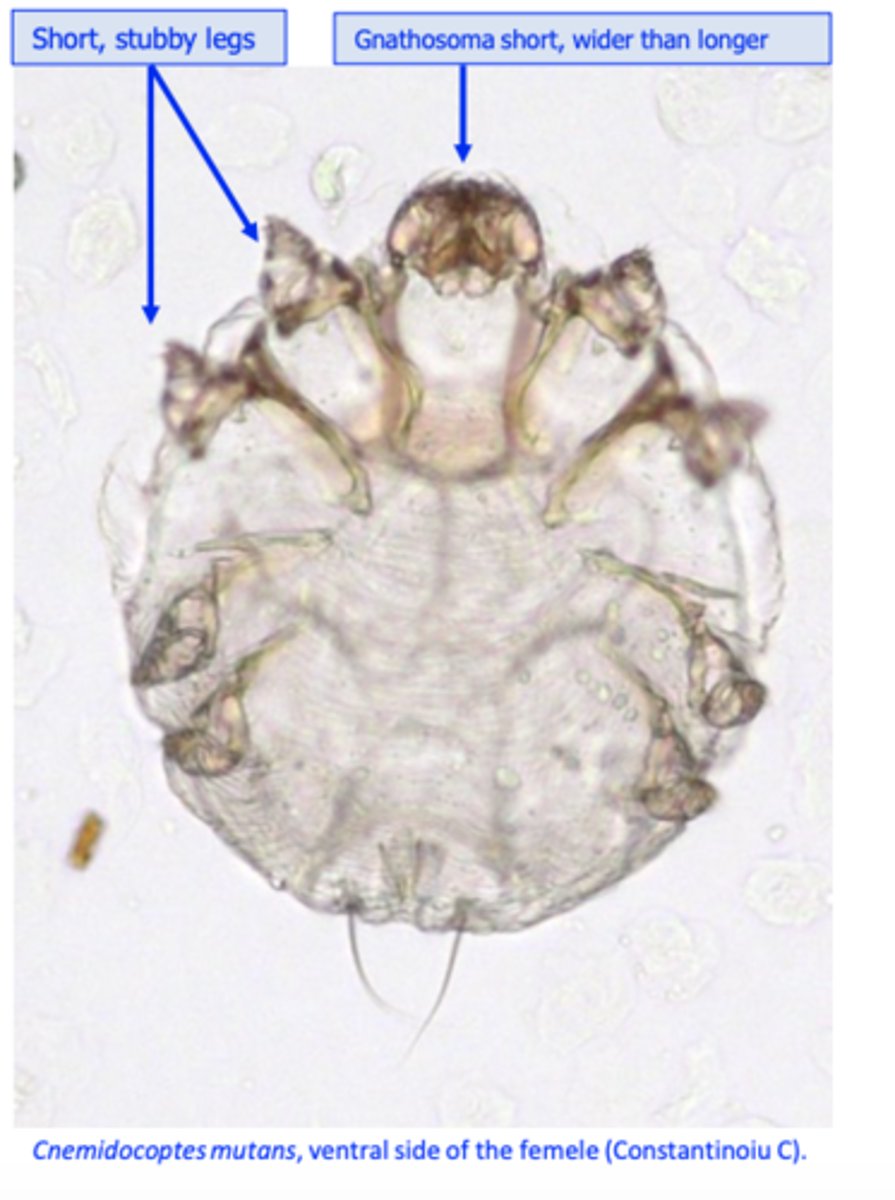
Cnemidocoptes mutans
Pathogenesis/Pathology
• Lesions are produced on the unfeathered portions of the legs
The parasites burrow under the epidermal scales of the legs and feet => irritation and inflammation => exudate which hardens to form crusty, proliferative masses;
Within these proliferative lesions mites create numerous tunnels => gives the lesions a honeycomb appearance when examined microscopically;
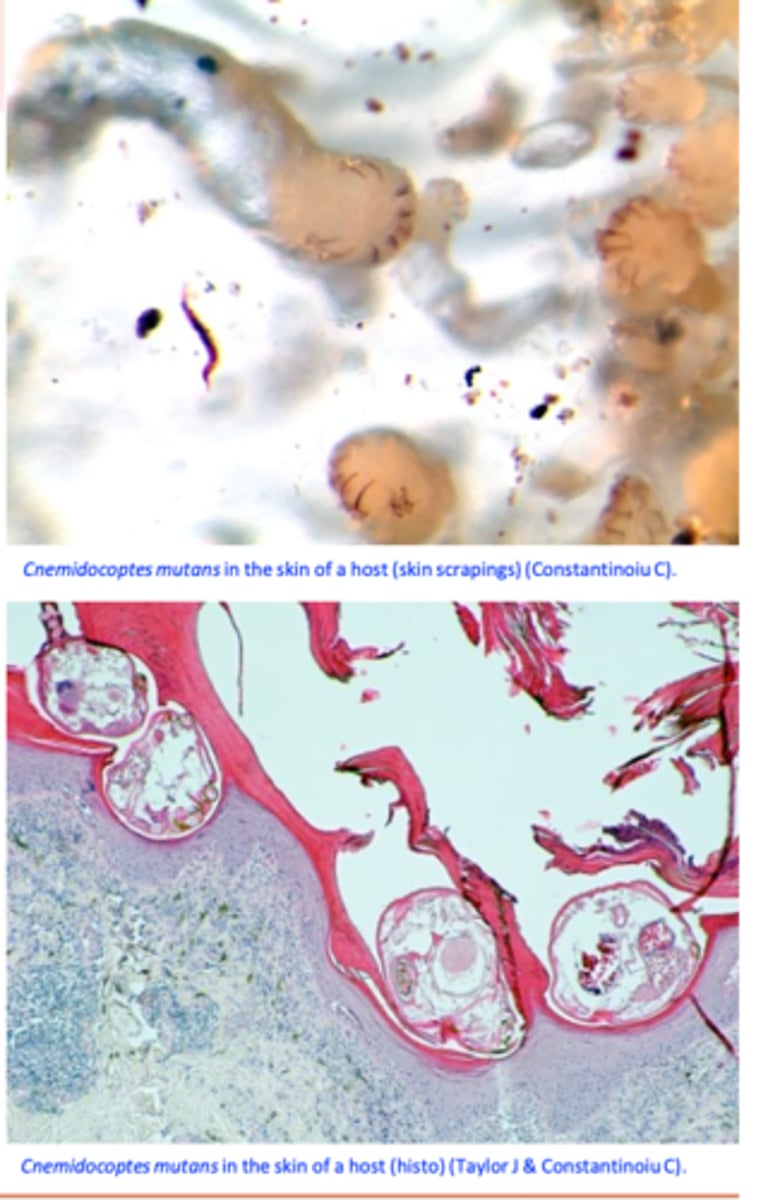
K(C)nemidocoptes mutans
Clinical signs
• Uplifting/upturning of the scales and crusty proliferations develop;
• In severe infestations the birds have reduced joint motility, may be crippled and have legs deformed;
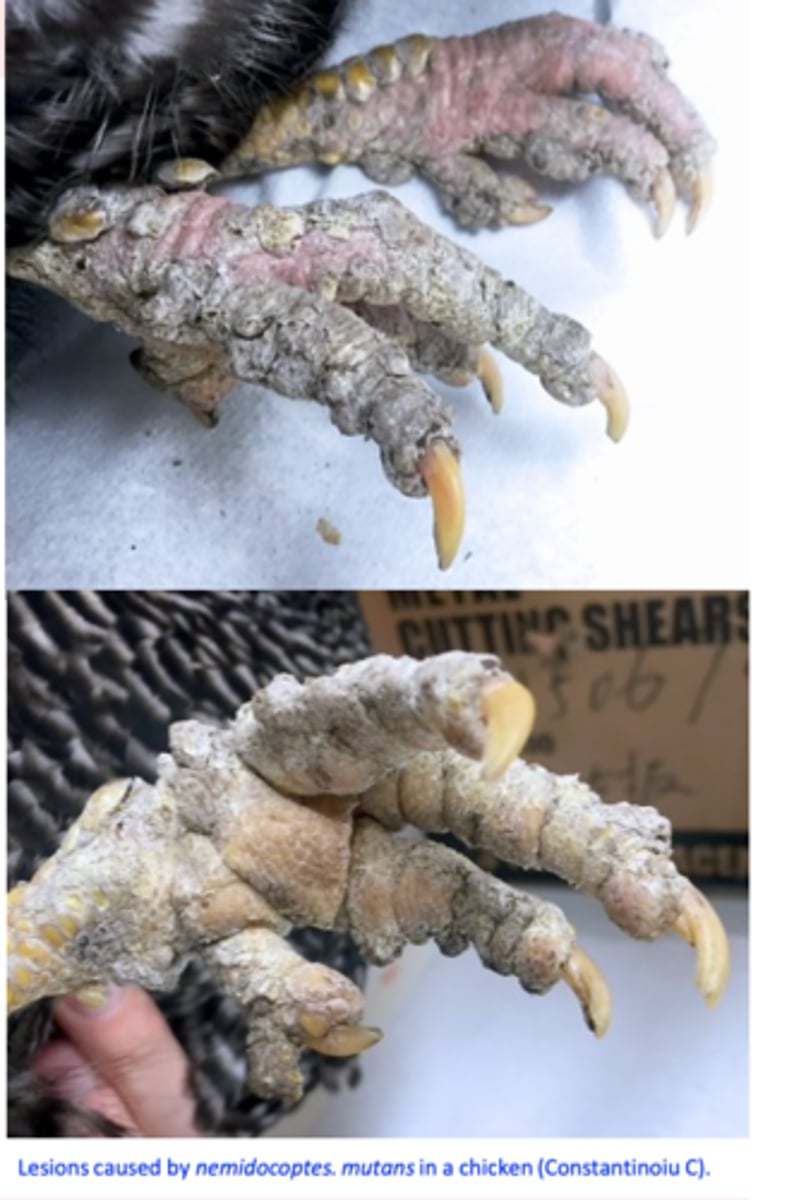
K(C)nemidocoptes mutans
Diagnosis
Clinical signs;
Identification of the mites in scrapings of the skin with lesions;
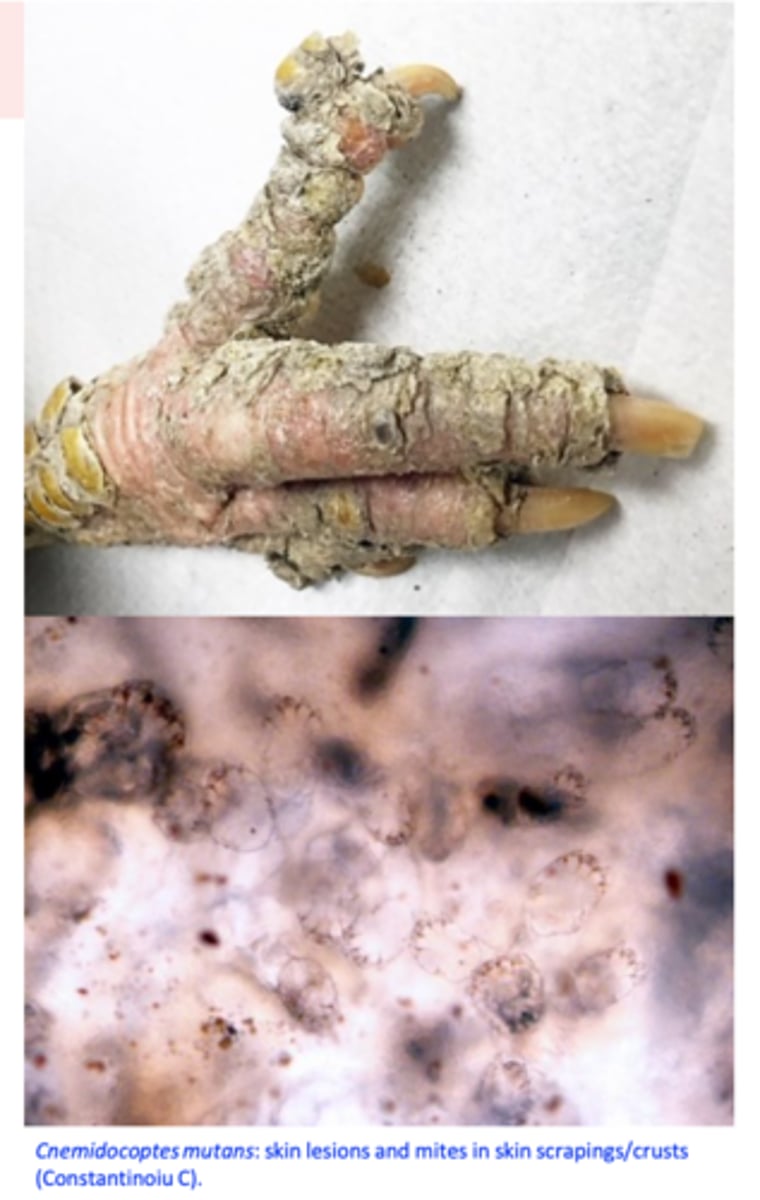
K(C)nemidocoptes mutans
Treatment
Birds can be treated by dipping the legs in acaricidal solutions
• Ivermectin per os/topical and Moxidectin: effective but ... not approved, residues in the meat/eggs etc.
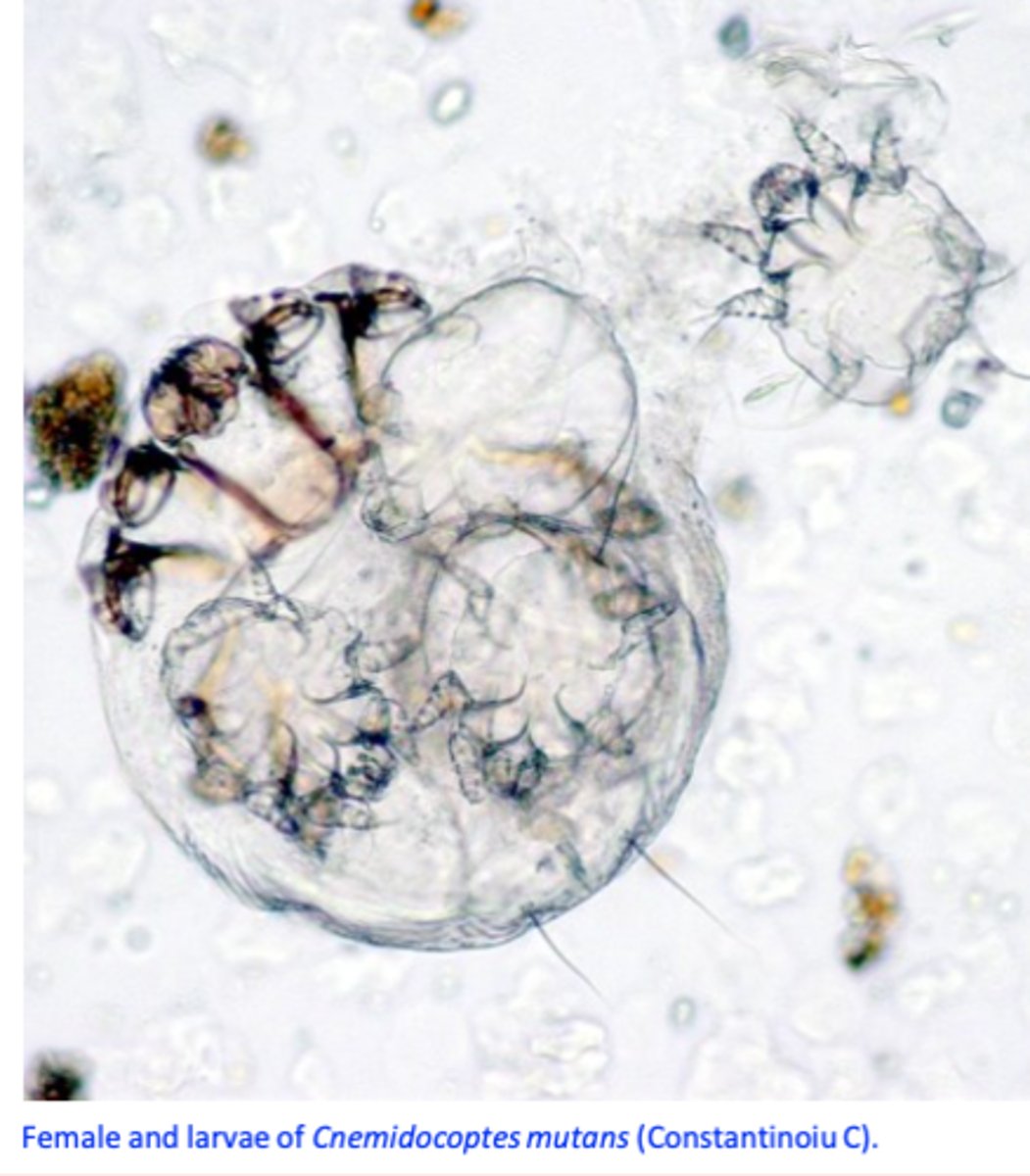
K(C)nemidocoptes gallinae: Depluming mite, depluming itch mite)
Hosts: chickens, pigeons, pheasants;
Morphology
• Similar to that of C. mutans except that the females lack the ‘scaly aspect’ on the dorsal side of body (striations are not broken/interrupted);
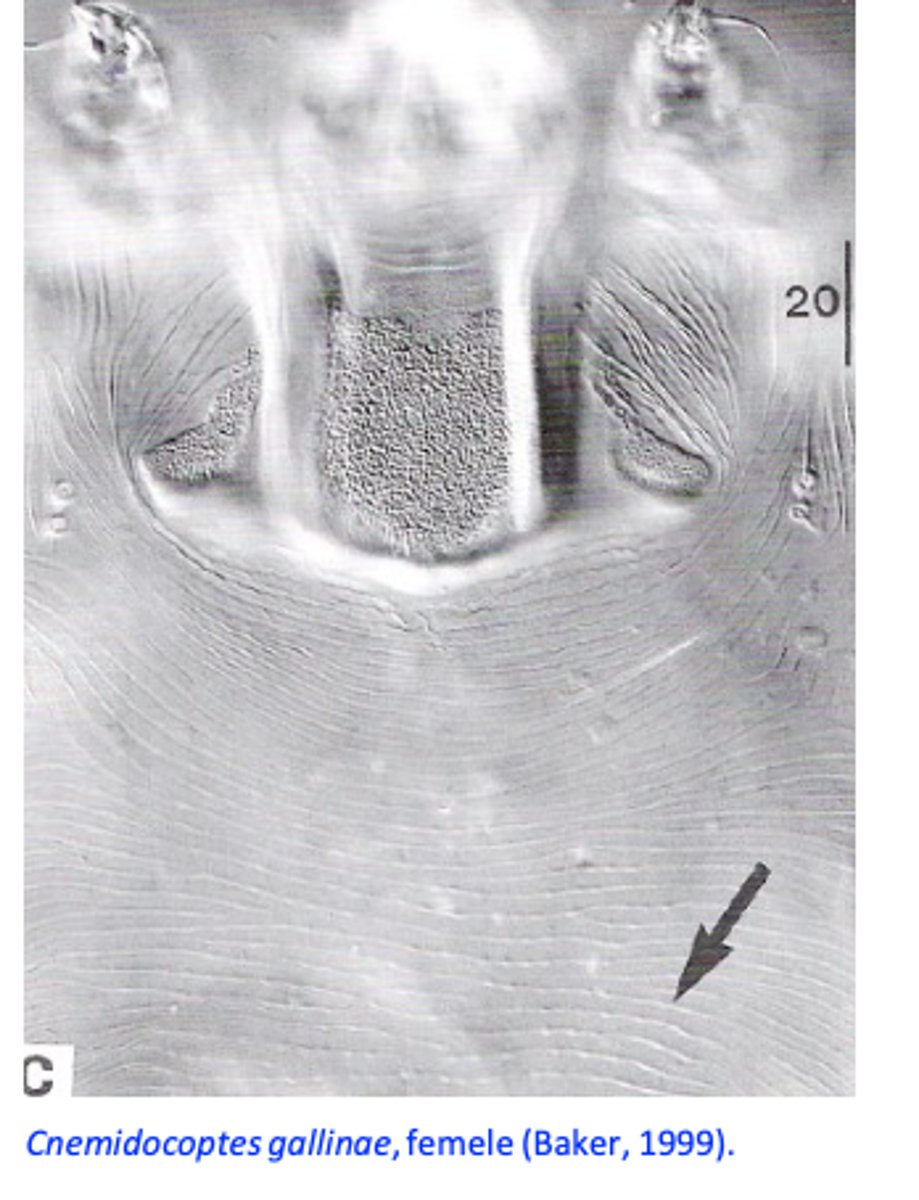
Cnemidocoptes gallinae
Pathology/Clinical signs
Mites burrow into feather shafts and upper layers of epidermis
Intense itch causes birds to pull out feathers “depluming itch”;
Loss of feathers over body, mites in feather shafts;
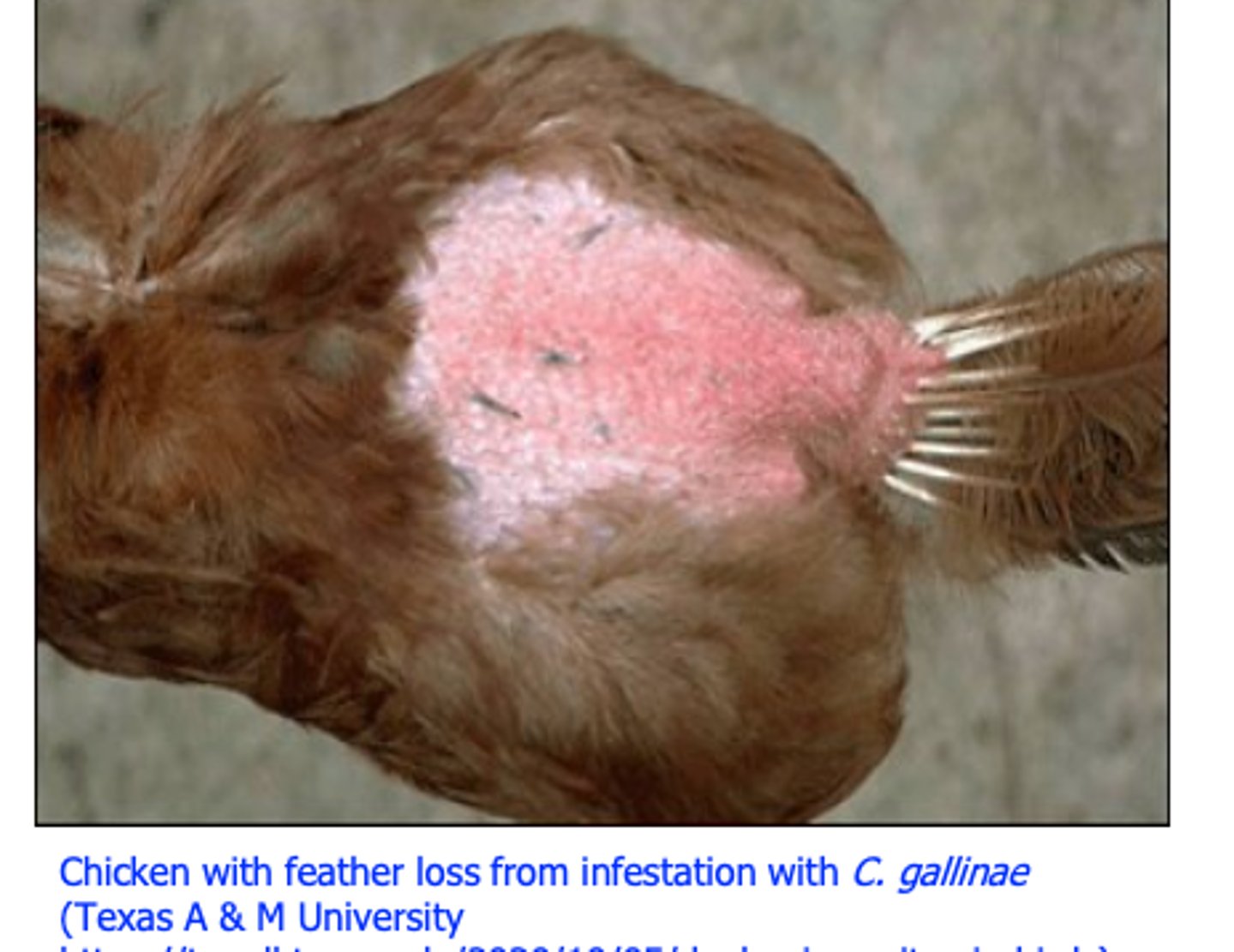
Cnemidocoptes pilae: Scaly face mite
Hosts: budgerigars, rainbow lorikeets, parrots etc;
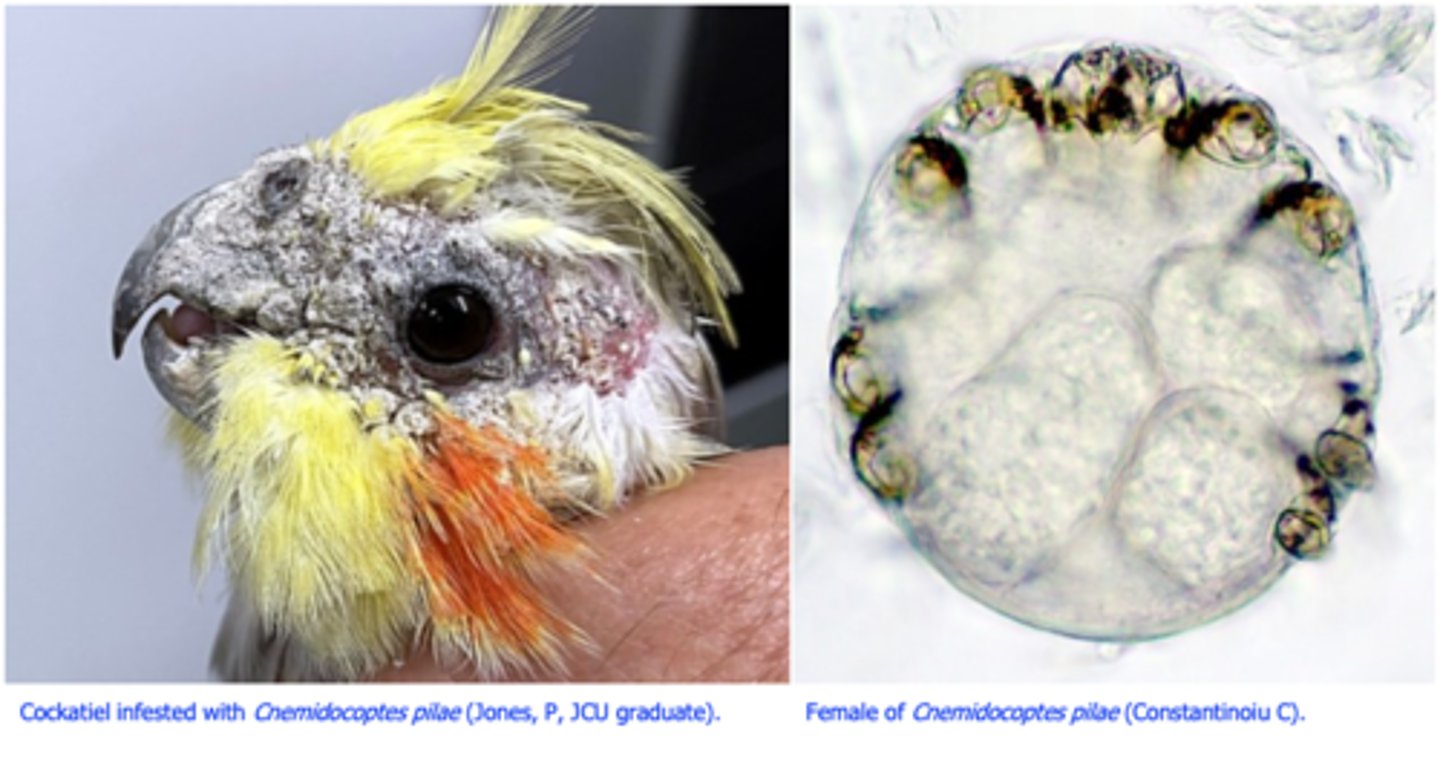
Cnemidocoptes pilae: Scaly face mite MORPH/LIFECYCLE
Morphology/life cycle
• Similar to those of Cnemidocoptes mutans;
Cnemidocoptes pilae: Epidemiology
Most common in fledglings and young adults;
Not all birds within a cage are affected => disease is associated with immunosuppression, stress, genetic factors etc;
Transmission: direct contact
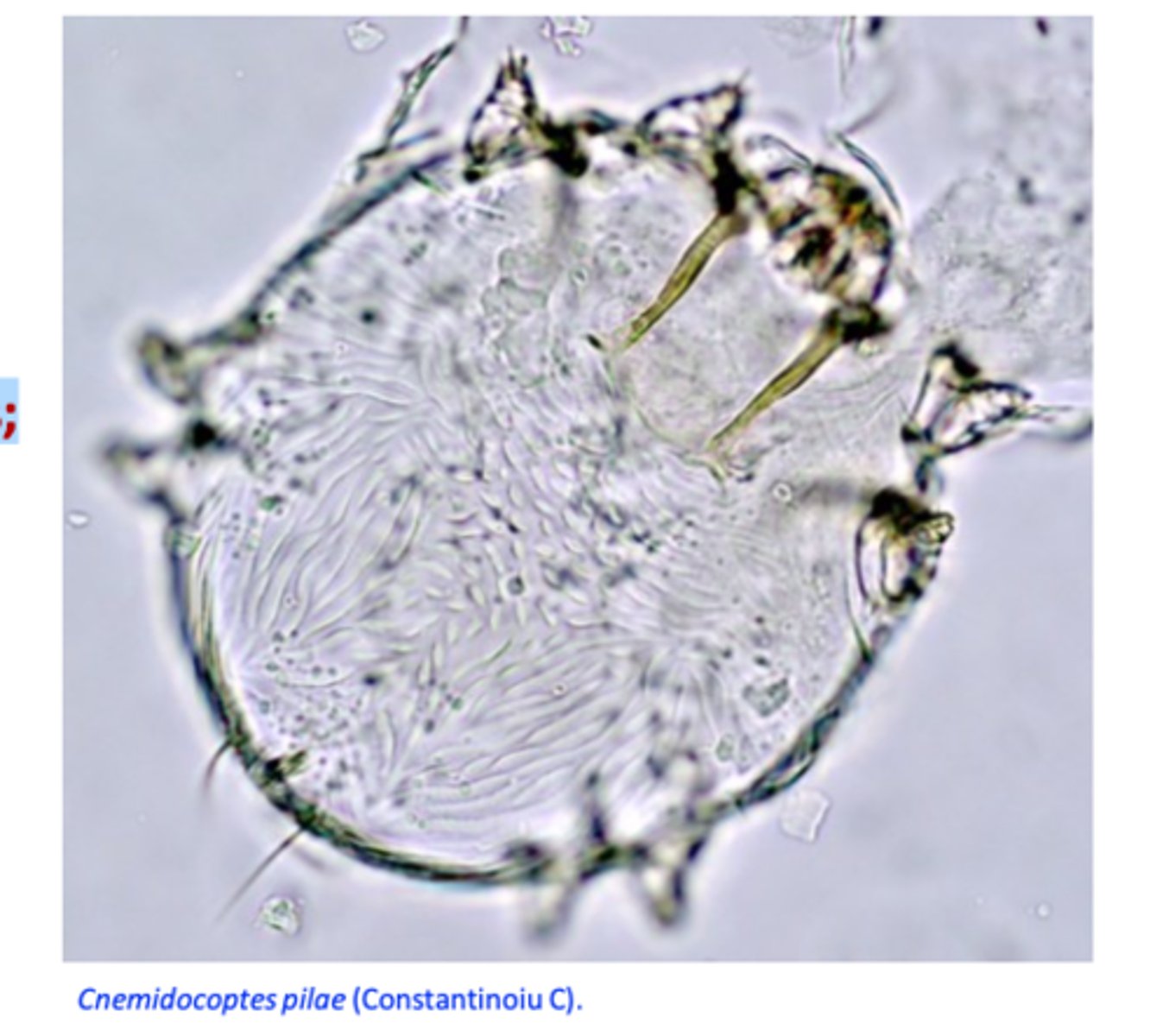
Cnemidocoptes pilae
Clinical signs
• Thick-white, honeycomb like crusts on non-feathered skin:
• Beak => deformed beak => difficulties in respiration and /or feeding;
• Eyes;• Legs and cloaca;
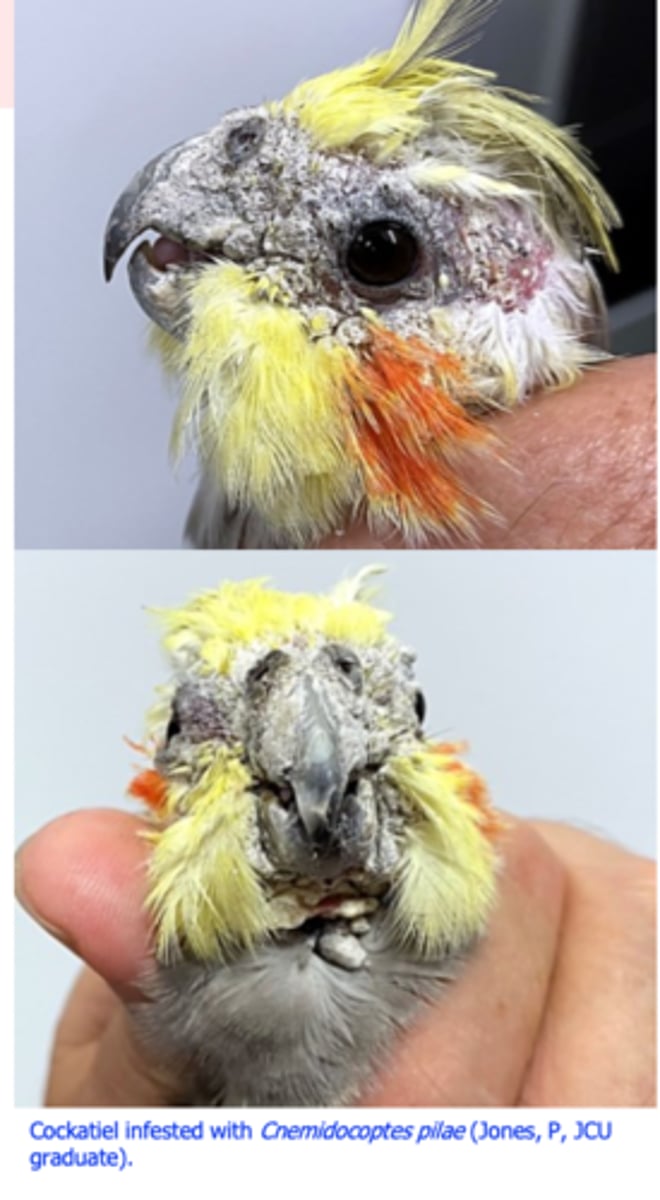
Cnemidocoptes pilae: Scaly face mite Diagnostic
Facial lesions are pathognomonic;
Confirmed by finding mites in skin scrapings
Cnemidocoptes pilae TREATMENT
• Ivermectin
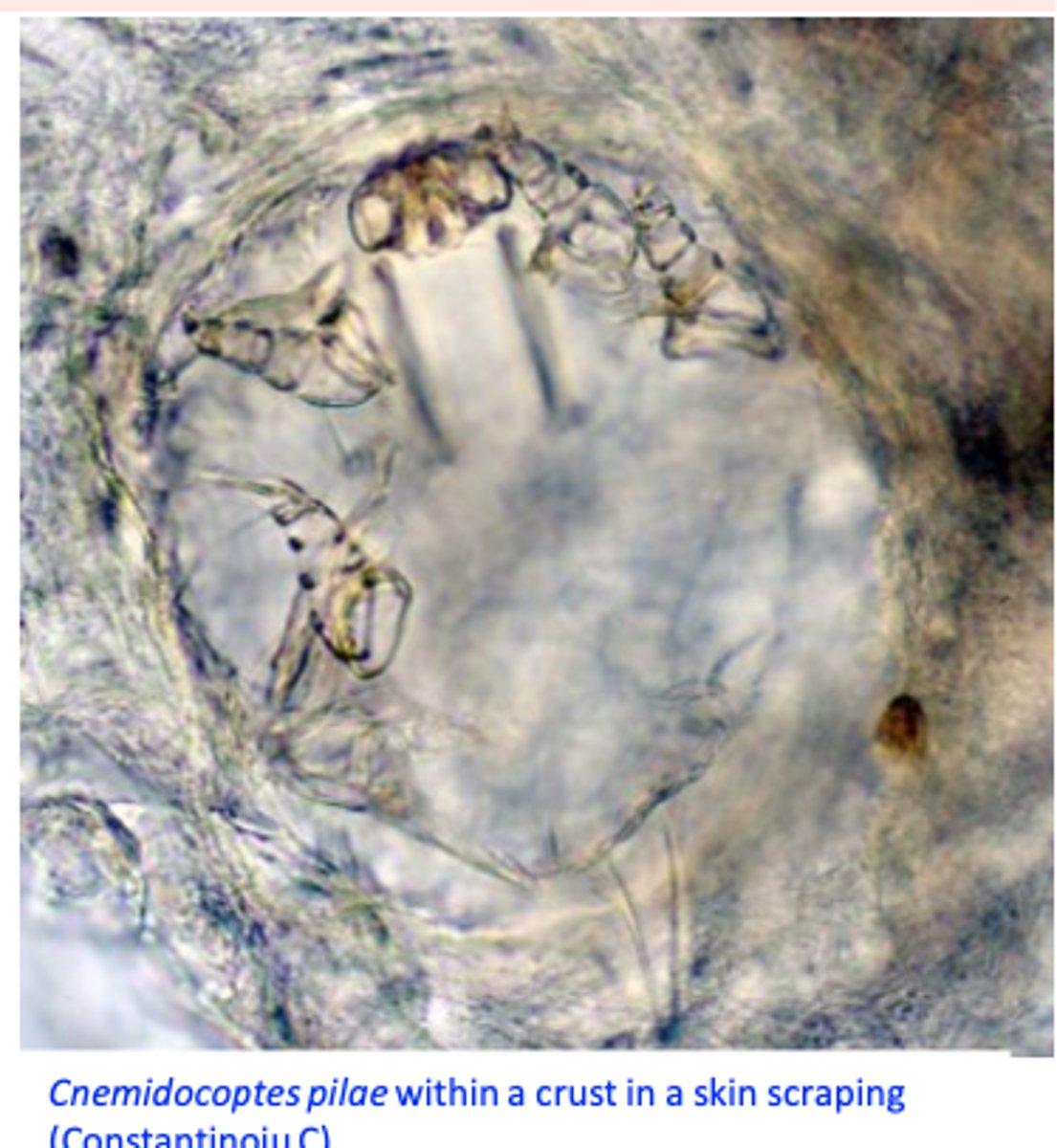
Lice in poultry
All species are chewing lice: feed on feather products but Menacanthus stramineus can feed on blood as well;
Have body areas that they prefer;
Menacanthus stramineus
• Most common and pathogenic louse of poultry;
Host
Chicken, turkey but also domestic guinea fowl, peafowls, quail, and pheasants
Common around the vent but also abdomen, breast, back, head, neck etc;
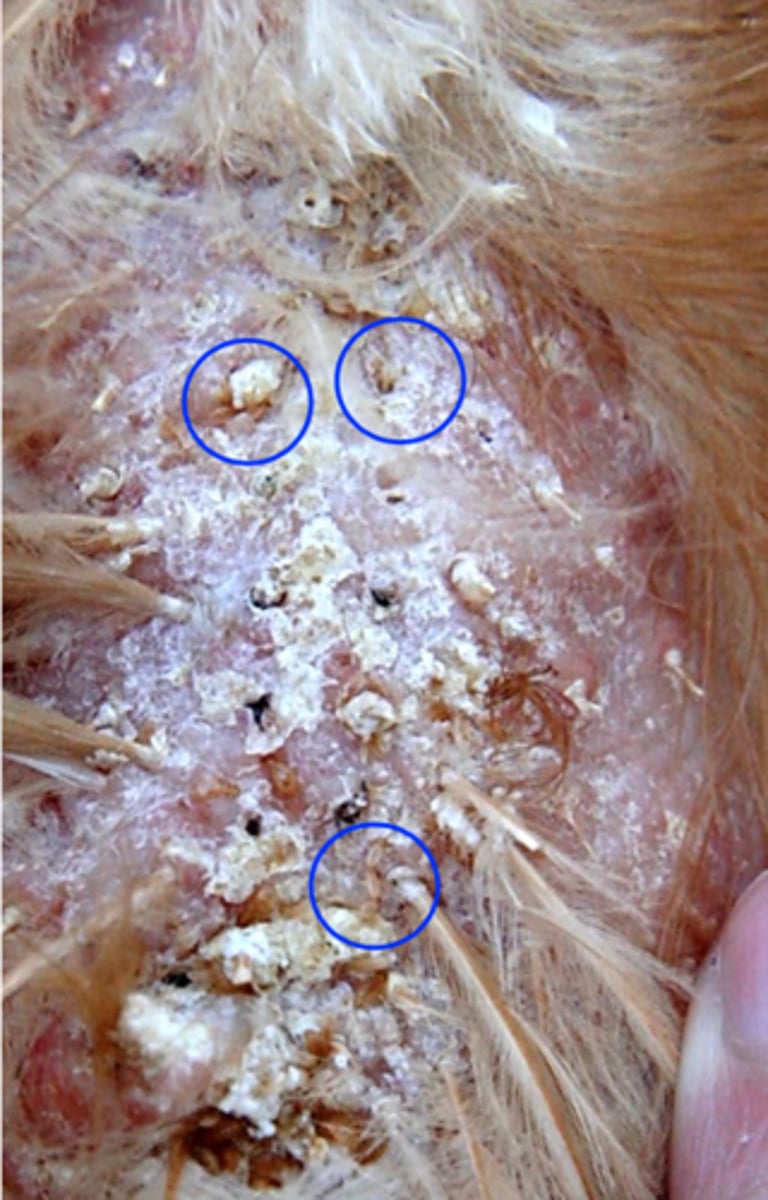
Menacanthus stramineus: Chicken body louse Morphology
• Head: triangular, wider than the
thorax;
• Two short, spinelike processes on the ventral side of the head;
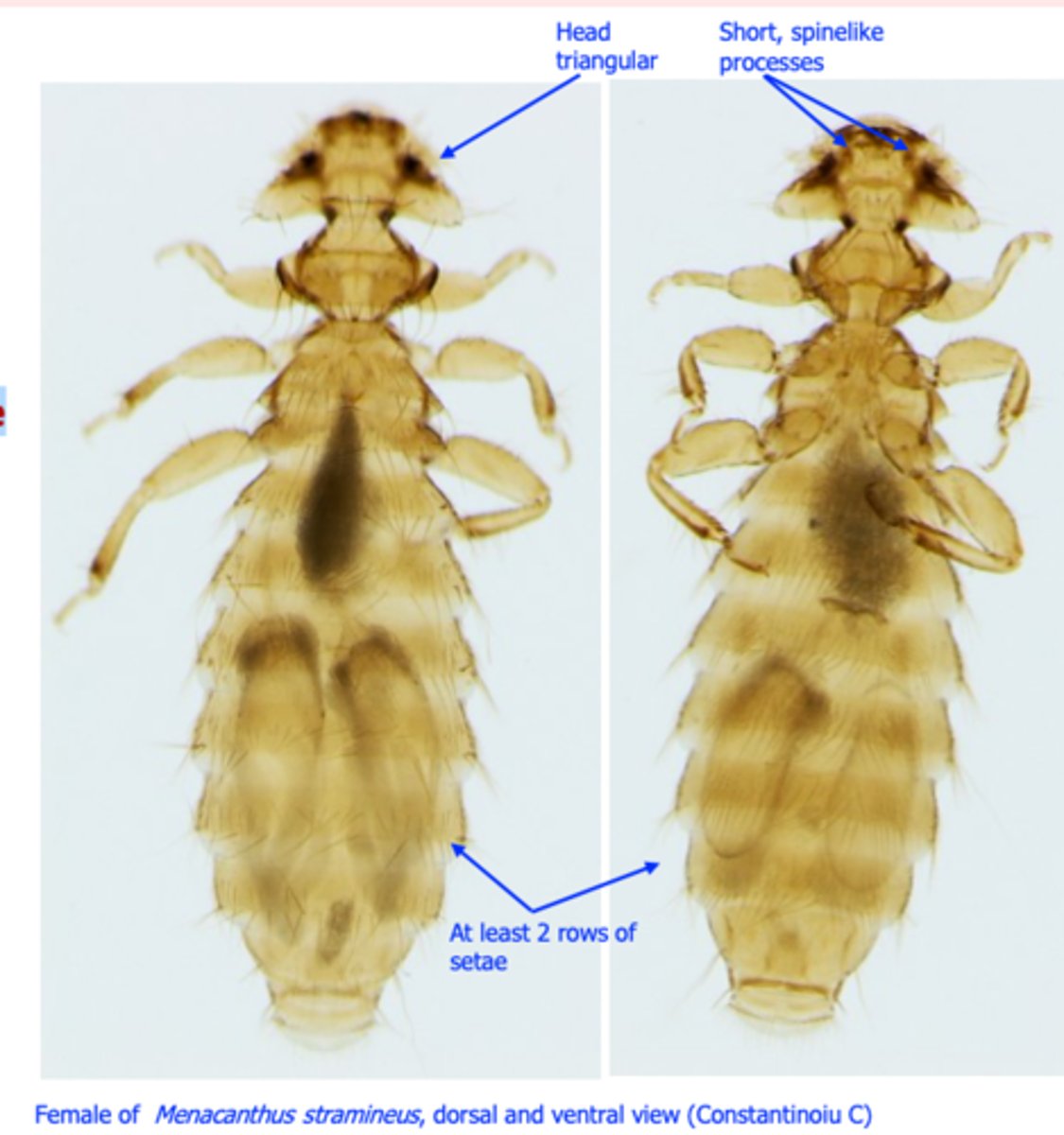
Menacanthus stramineus: Chicken body louse PHOTO
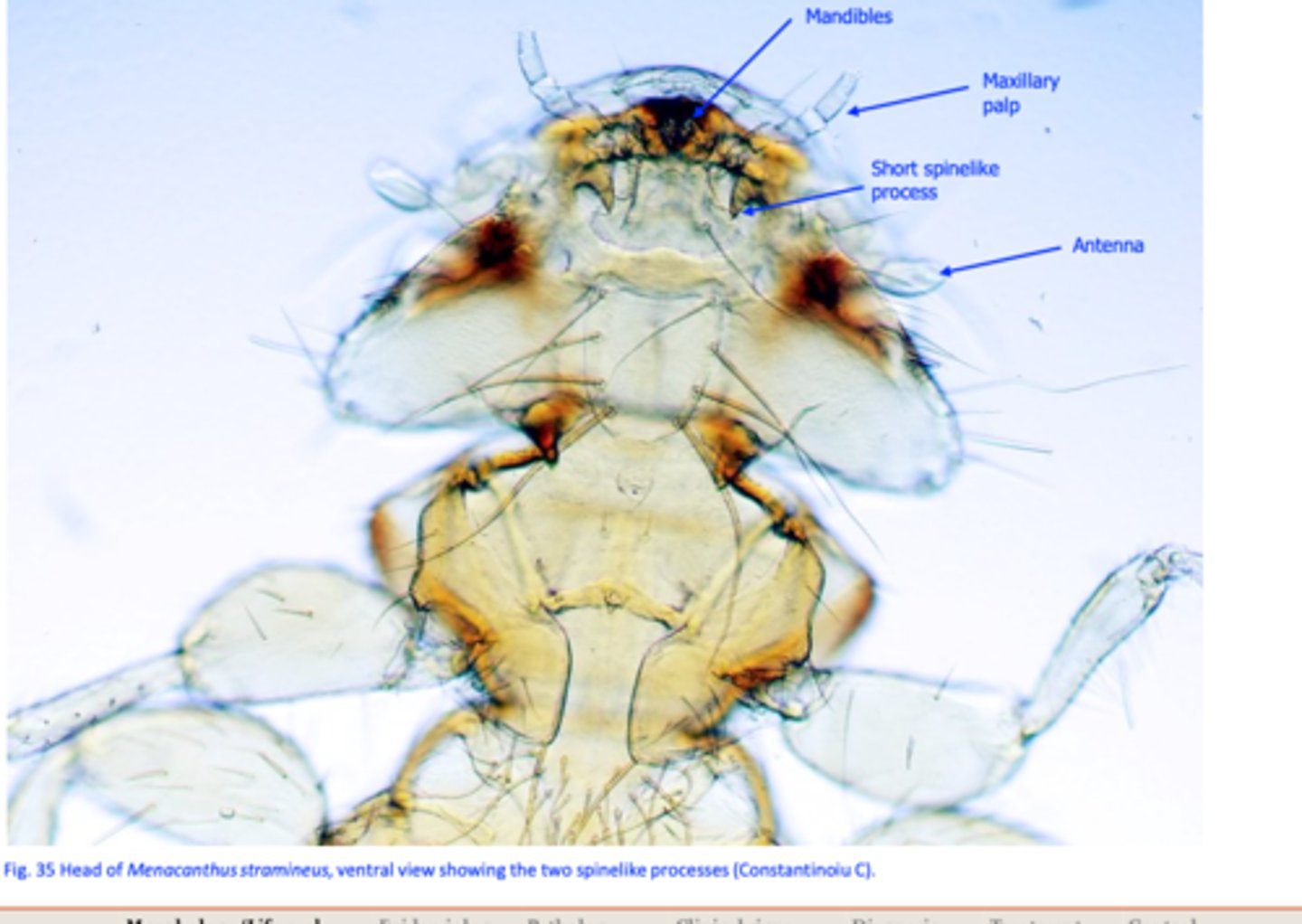
Menacanthus stramineus: Chicken body louse Life cycle
All stages occur on the host;
Eggs are glued in clusters or individually at the base of feathers;
Completed in 3 weeks;
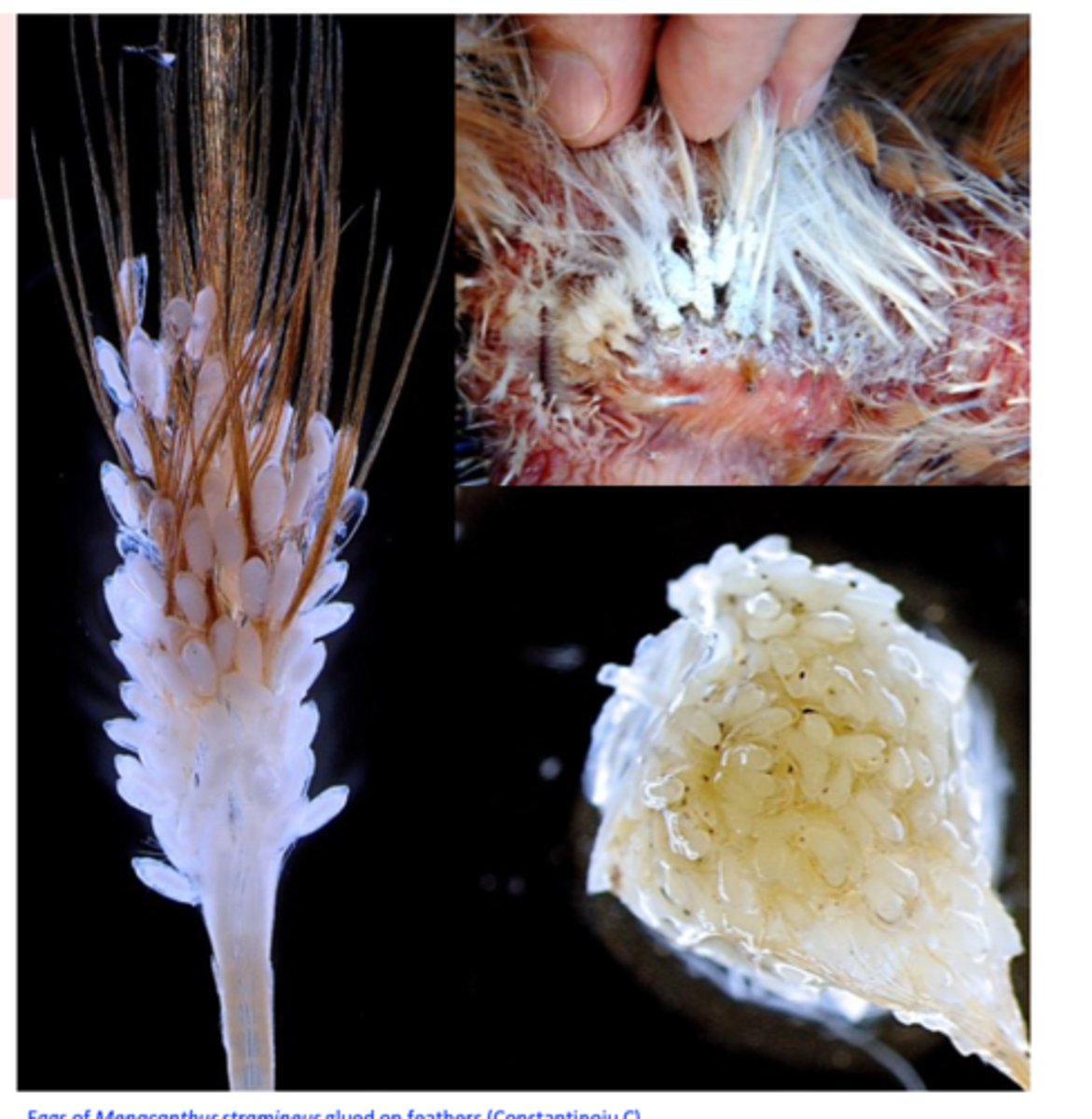
Menacanthus stramineus: Chicken body louse Epidemiology
• Common in outdoor systems
• In intensive systems lice are generally present in caged layers and floor breeders
• Birds of all ages are susceptible
Transfer: most often by direct contact
Lice can be introduced to a farm by restocking with infested birds, Generally,ested shipping crates, egg flats, cartons etc;
Generally populations of lice increase in the cold seasons;
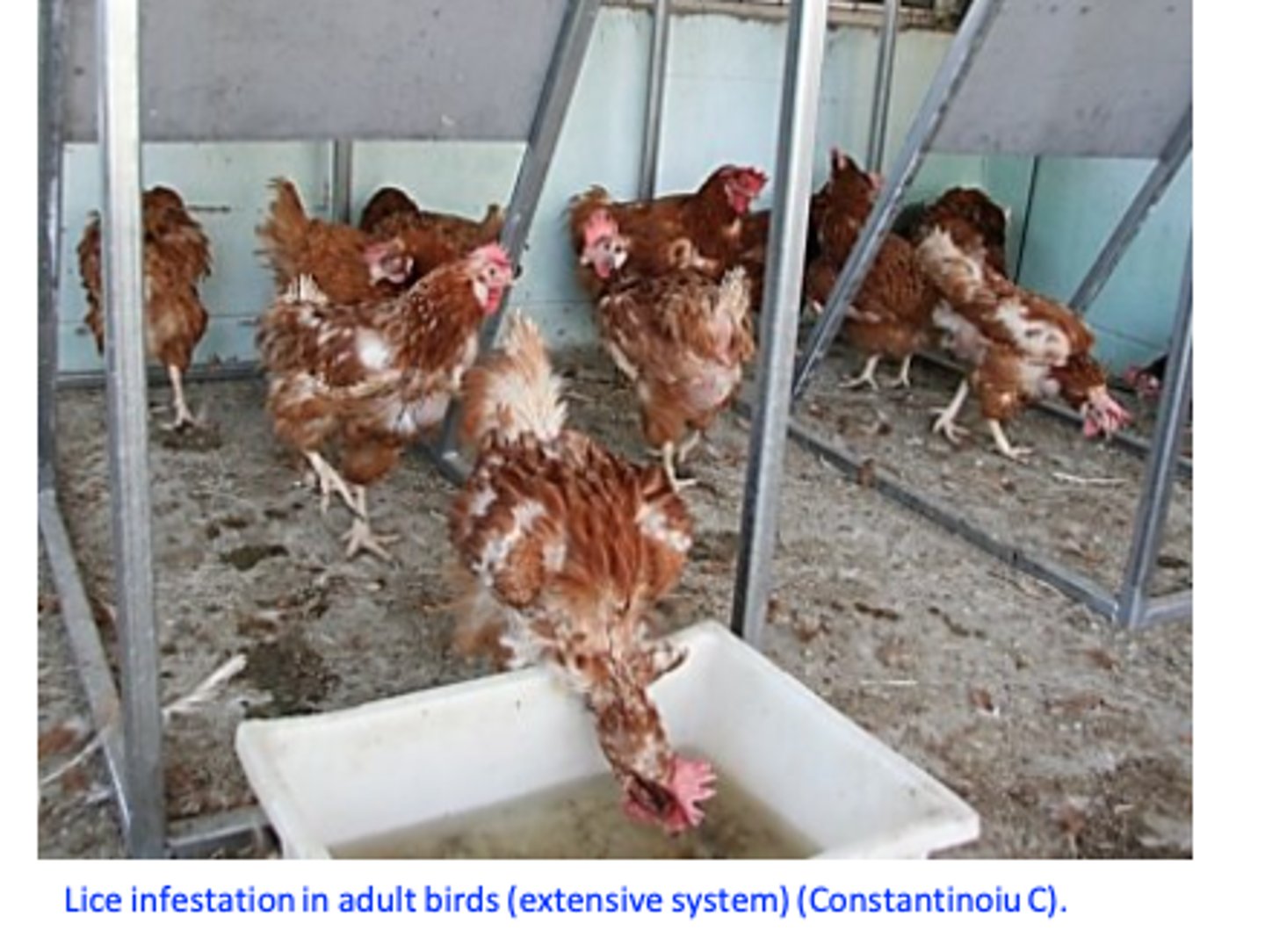
Menacanthus stramineus: Chicken body louse Effect on the host/clinical signs
• Irritation => pruritus => scratching => damage to the feathers and the skin, crusts;
• Birds are restless => weight loss & low egg production; bedraggled appearance;
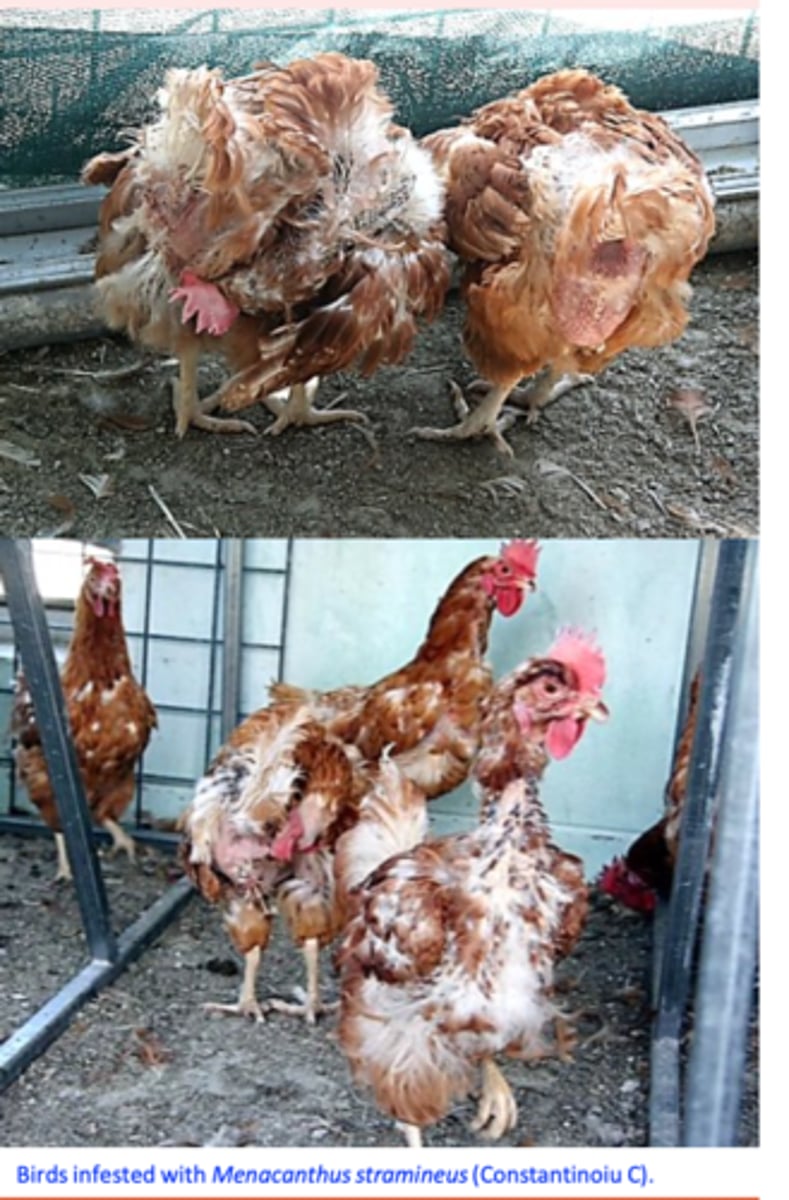
Menacanthus stramineus -
Reddening of the skin, which eventually becomes scabby;
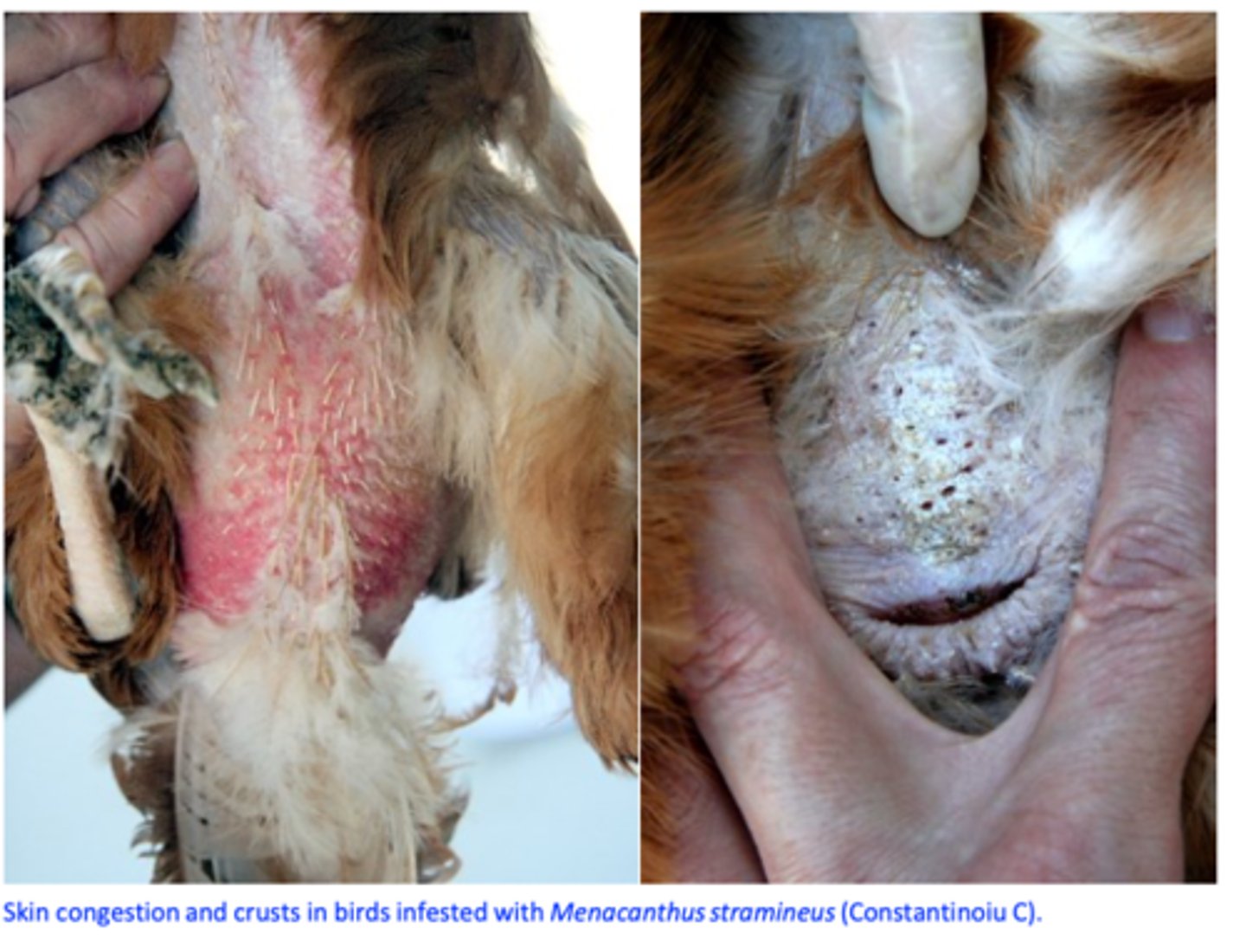
Menacanthus stramineus
Diagnosis
• Clinical signs and history;• Identification of the lice on the skin and feathers and eggs on the feather
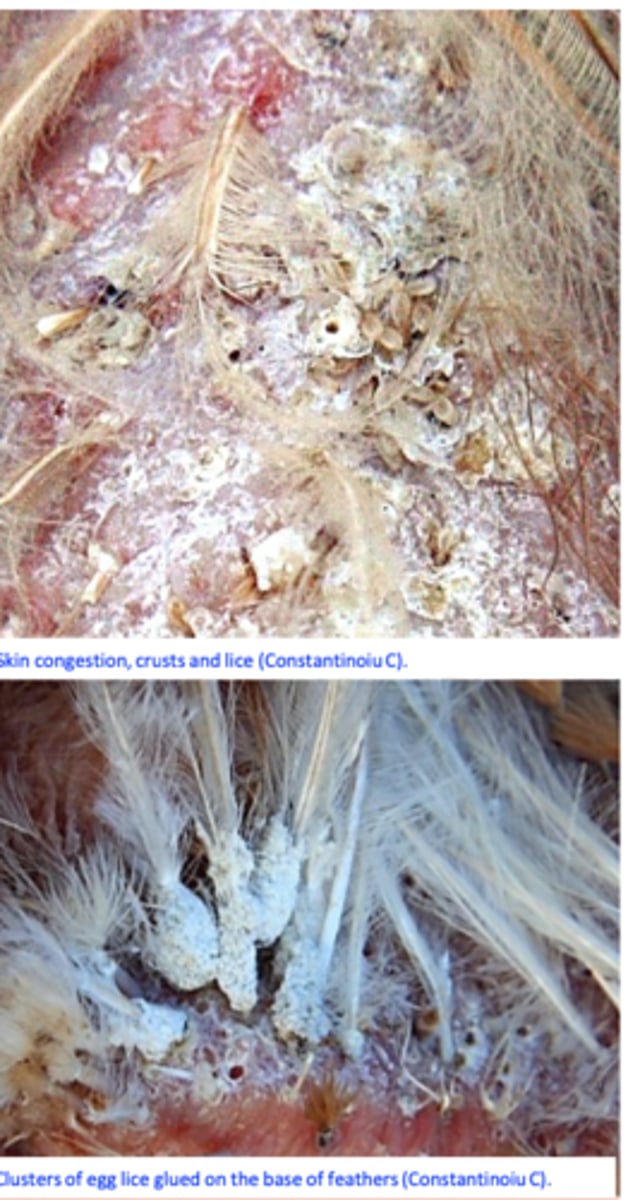
Treatment/Control
Spray the poultry with an approved insecticide - Maldison 50
Generally insecticides are not active against eggs
=> repeat treatment after 7-10 days;
Check/treat newly acquired birds
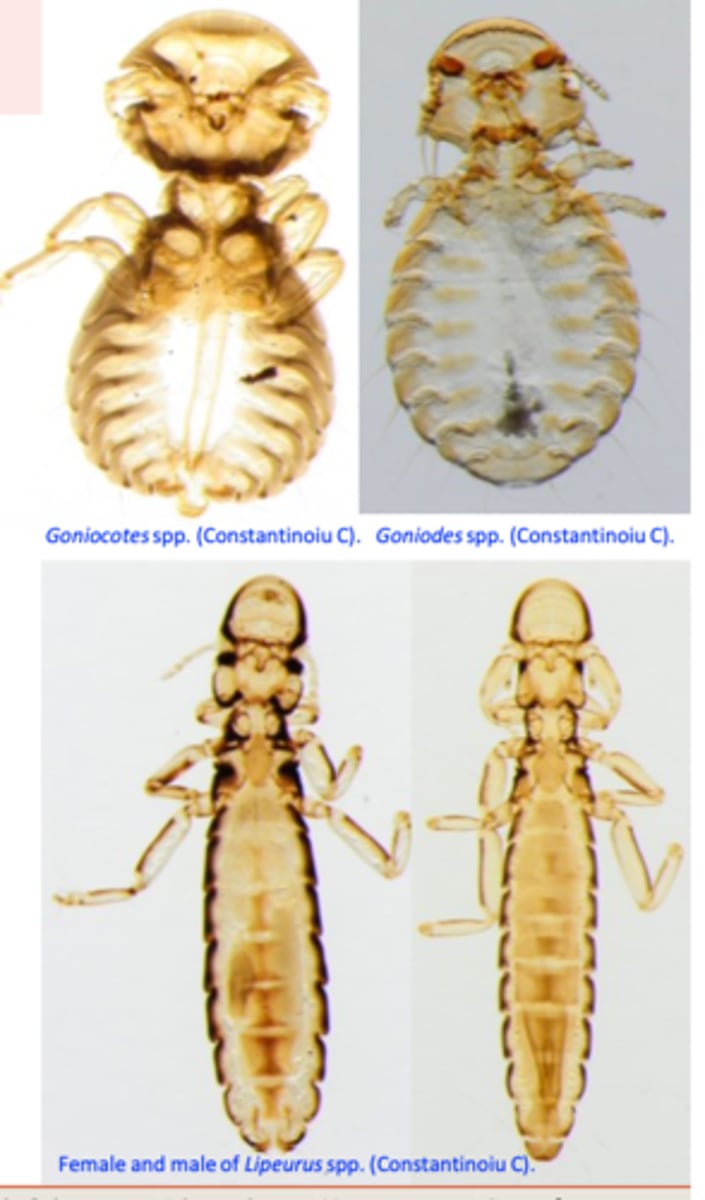
Echidnophaga gallinacea
Sticktight/stickfast flea
Host: birds, dogs, cats, rabbits, humans etc.
• Young birds infested with this flea are likely to die;
• Can attack humans, dogs, cats, goats, horses, kangaroos etc;
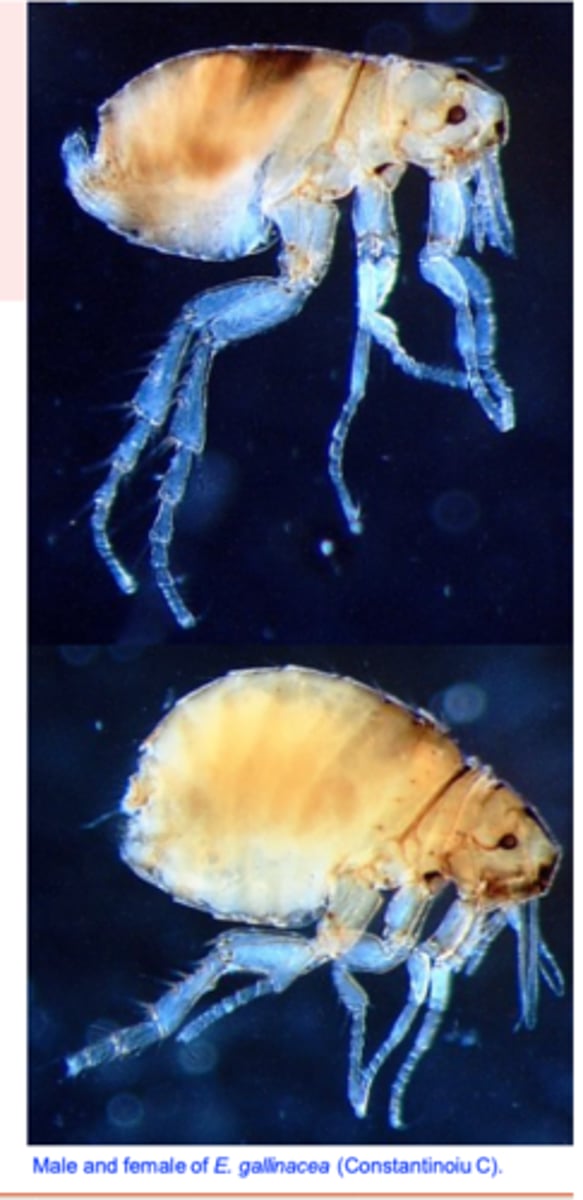
Echidnophaga gallinacea
Morphology
No ctenidia (no combs);
Angular head;
Thorax reduced dorsally
Mouthparts are long
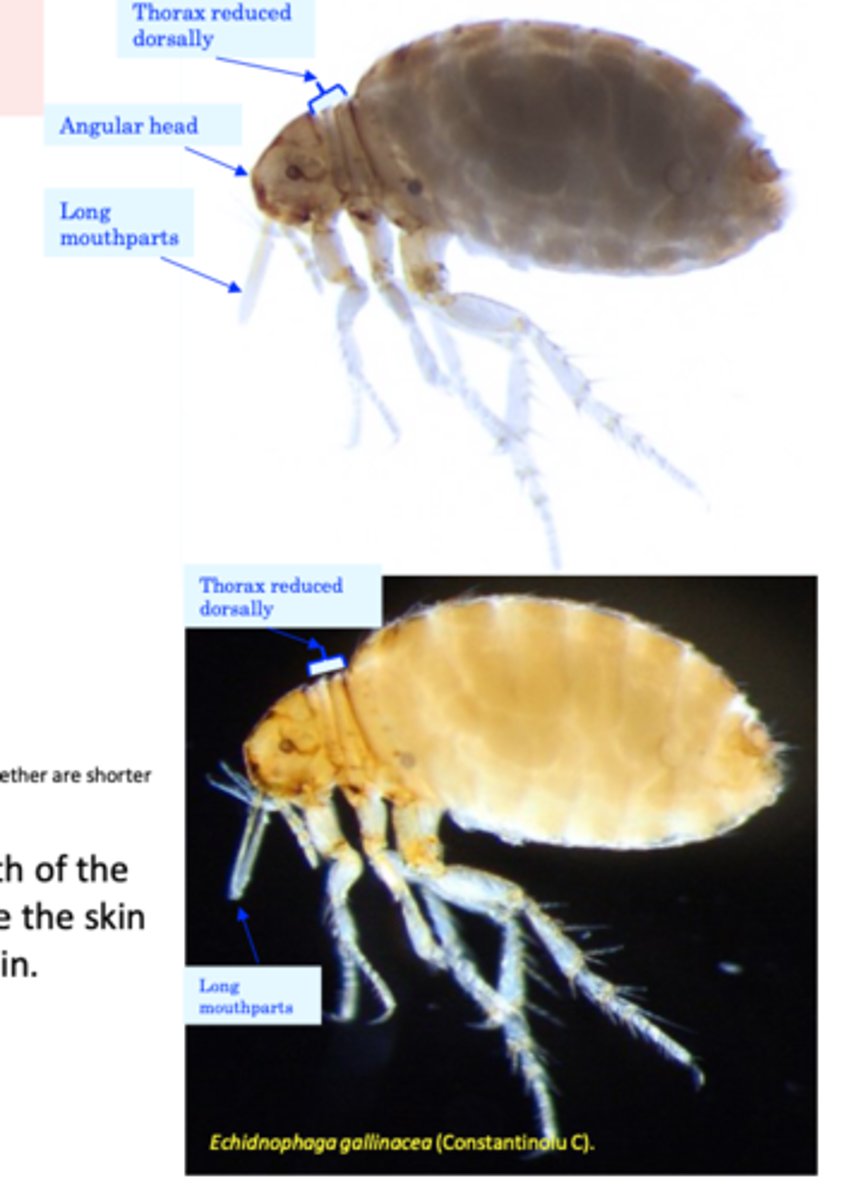
Echidnophaga gallinacea: Life cycle
• Female fleas burrows into the skin where they attach firmly with their mouthparts => the skin around might become ulcerated;
After copulation females lay 1-4 eggs/day that fall on the ground
On the ground larvae hatch from eggs in 1-2 weeks => feed on chicken manure and flea excrements;
L1 =>L2 => L3 in 2-4 weeks; L3 spins a cocoon => pupa => adults;
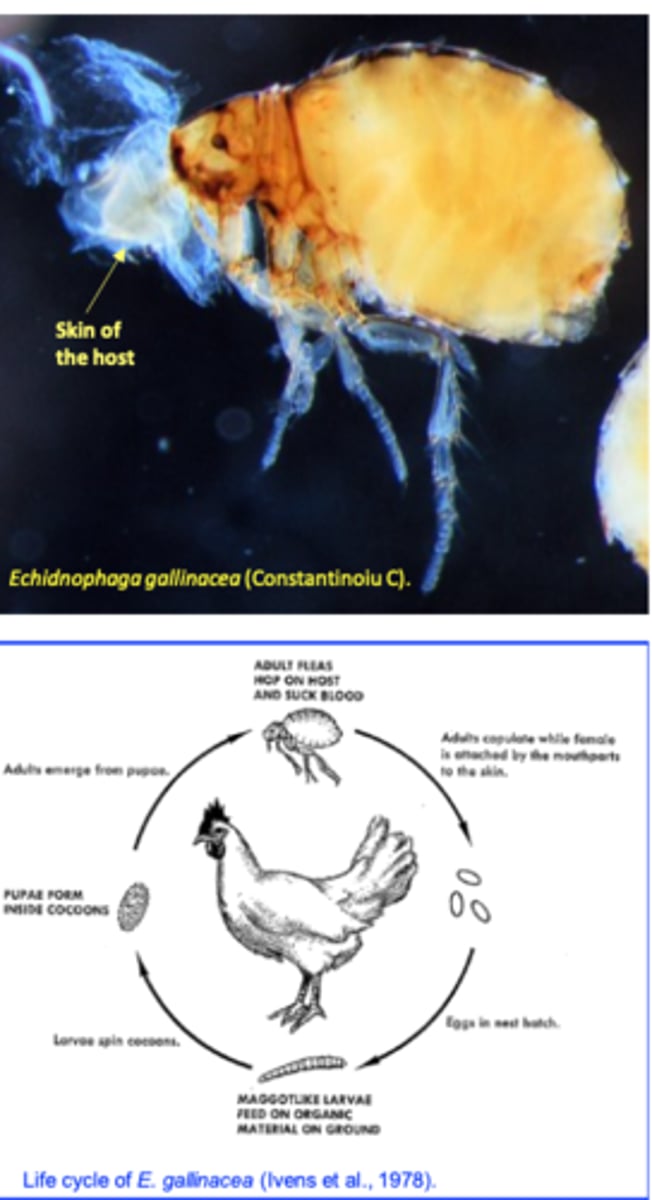
Echidnophaga gallinacea: Epidemiology
Found on birds, especially poultry, but also on dogs, cats, humans, rabbits, goats, horses, kangaroos
Common in tropical areas but may be found in subtropical and temperate areas as well;
Common in areas with sandy soil in birds grown in outdoor systems;
Transmission: from environment, when the host enters contaminated area;
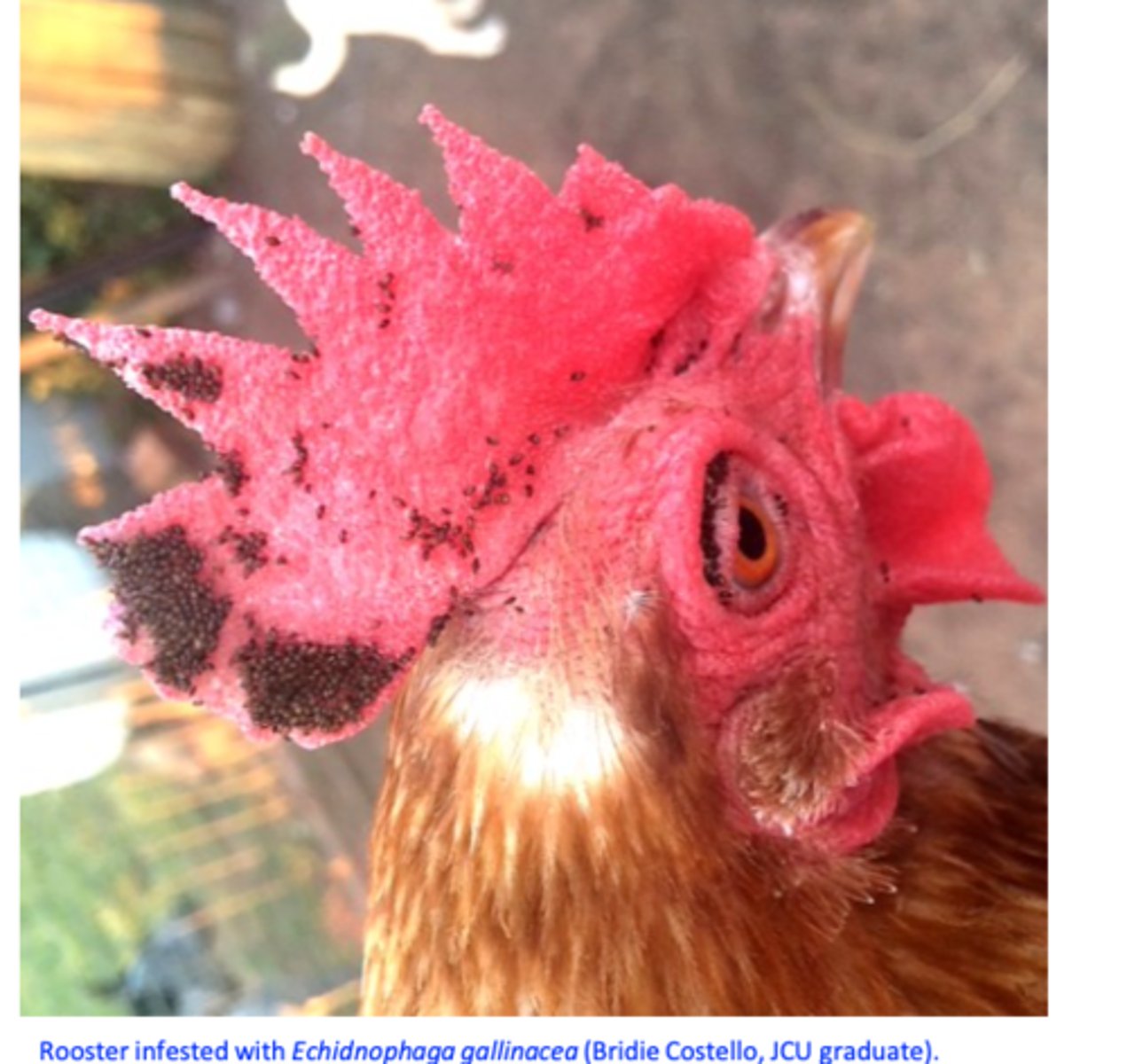
E. gallinacea: Effect on the host/Clinical signs
• Adults usually attach to skin of the head, often in clusters
of 100 or more; other locations: comb, wattles
• Females burrow into the skin => mouthparts are deeply embedded in the skin => difficult to dislodge;
The skin around the point of attachment becomes ulcerated => bacterial complications;
Irritation => scratching => birds can injure the eyes =>blindness => starvation;
In large numbers might cause anemia and emaciatioon;
Death may occur in young birds;

Echidnophaga gallinacea: Control
• Confinement of poultry;
• Provision of impervious floor;
• Regular removal of (contaminated) droppings and cleaning of the sheds;
• Regular treatments of birds, environment
• Elimination of shaded places;